Green Shirt Day: Father makes sacrifice for son
Arviat dad donating kidney to his ailing teenager

ITK seeks $1.6 billion from Ottawa for school foods program
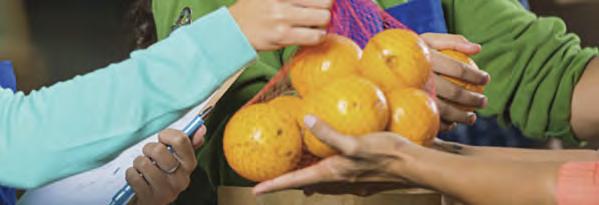
Iqaluit student reflects on $100,000 scholarship and her goals

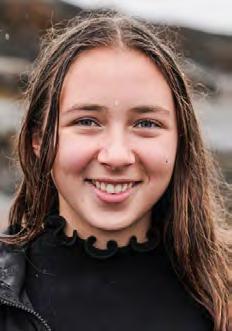
Winners revealed at Arctic Music Awards
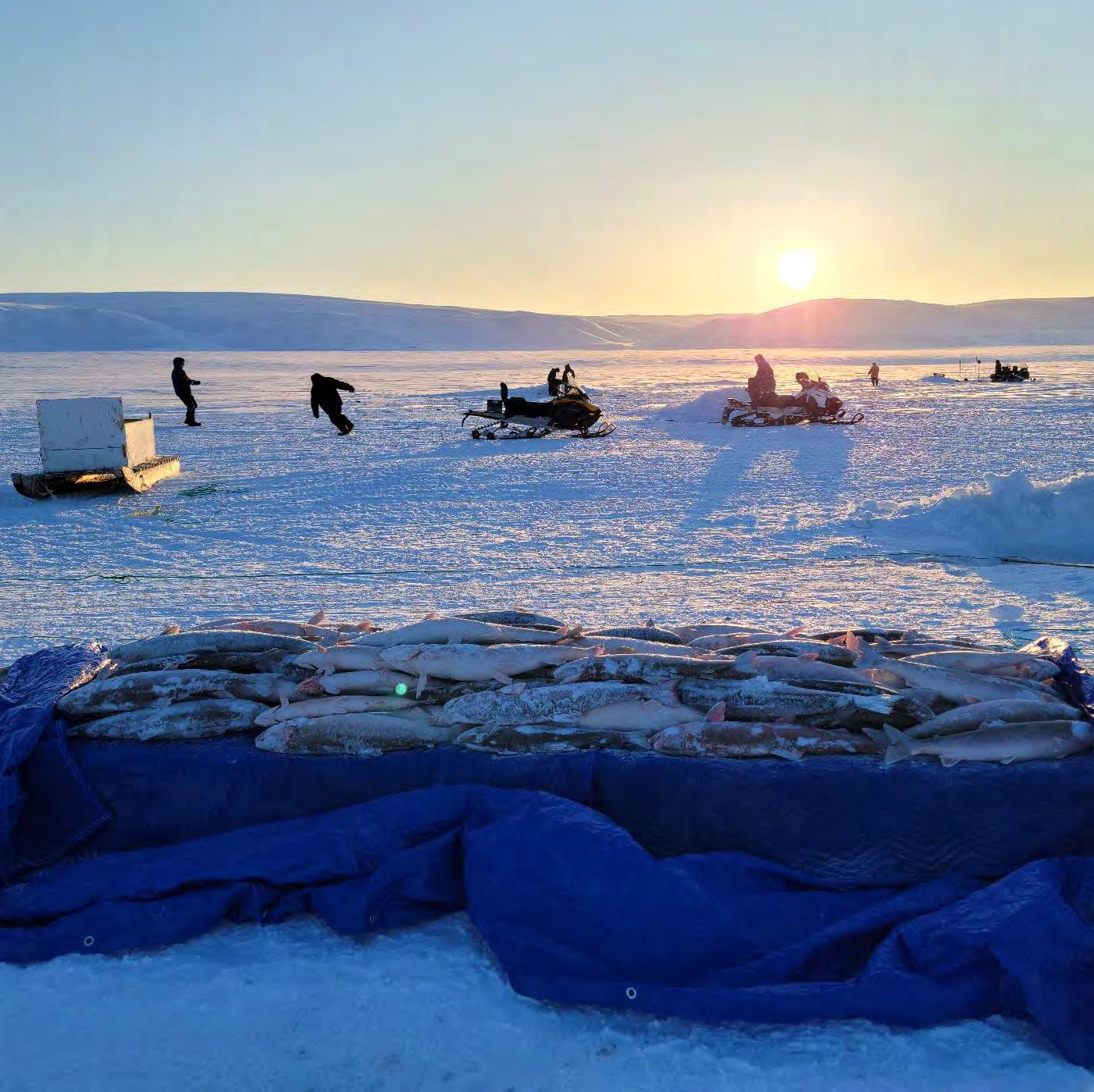
Volume 77 Issue 46 MONDAY, APRIL 3, 2023 $.95 (plus GST) Publication mail Contract #40012157 7 716050020 0 2 Education ᐃᖃᓗᖕᓂ ᐃᓕᓐᓂᐊᖅᑎ $100,000-ᓂᒃ ᐃᓕᓐᓂᐊᕈᑎᒃᓴᖅᑖᖅᐳᖅ ᑐᕌᒐᖏᓪᓗ Health ᐃᓄᐃᑦ ᑕᐱᕇᑦ ᐃᓄᐃᑦ ᑕᐱᕇᑦ ᓄᓇᕗᒻᒥ ᕿᓂᖅᐳᑦ $1.6 ᐱᓕᐊᓐ ᐋᑐᕚᒥᑦ ᐃᓕᓐᓂᐊᕐᕕᖕᒥ ᓂᕆᔭᒃᓴᓄᑦ ᐱᓕᕆᐊᓄᑦ Arts ᓵᓚᒃᓴᖅᑐᑦ ᓴᖅᑭᑕᐅᓛᖅᑐᑦ ᐅᑭᐅᖅᑕᖅᑐᒥ ᓂᔾᔭᐅᓯᔭᕐᓂᕐᒧᑦ ᑐᓐᓂᖅᑯᓯᐊᖅᑐᓂᒃ
ᐊᕐᕕᐊᓂ ᐊᑖᑕ ᑐᓂᓯᔪᖅ
ᑕᖅᑐᓂᒃ ᖁᖓᔮᖅᑐᒧᑦ ᒪᒃᑯᒃᑐᒧᑦ
Food for the table
ᔫᑕ ᓴᖅᐱᓇᖅ ᓇᒃᓯᐅᔾᔨᓚᐅᖅᐳᖅ ᑖᔅᓱᒥᖓ ᐊᔾᔨᙳᐊᒥᒃ ᕿᑭᖅᑖᓗᖕᒥᑦ, ᑕᑯᒃᓴᐅᑎᑦᑎᓪᓗᓂ ᑲᔪᓯᓂᖃᑦᑎᐊᖅᑐᒥᒃ ᐅᓪᓗᒥ ᐃᖃᓗᒐᓱᖕᓂᕐᒥᒃ ᒫᑦᓯ 17−ᖑᑎᓪᓗᒍ, ᓯᓚᑦᑎᐊᕙᐅᓪᓗᓂ.
Juuta Sarpinak sent this image from Baffin Island, showing a successful day of fishing on March 17, with beautiful weather.
ᑐᖑᔪᕈᔪᒃᑐᒥᒃ ᐅᕕᓂᕈᖅᓯᒪᓐᓇᐅᑉ ᐅᓪᓗᖓ: ᐊᑖᑕ ᑐᓂᓯᖃᑦᑕᖅᑐᖅ ᐃᕐᓂᕐᒥᓂᒃ




Nunavut News kNKu W?9oxJ5 www.nunavutnews.com A2 Monday, April 3, 2023
Arviat father donating kidney to ailing son

Man loses 75 pounds to get in shape for surgery
When Daniel and son Hunter Kablutsiak suited up for Eskimo Point in the 2023 Terence Tootoo Memorial hockey tournament in Rankin Inlet this March, the pair were sharing more than jersey logos.
A year before, the Kablutsiak family had been on a search for a kidney donor for Hunter, now 16. Hunter was battling stage 4 kidney disease – now stage 5 – with his kidney operating at 16 per cent. Dialysis was scheduled to begin when he hit five per cent.
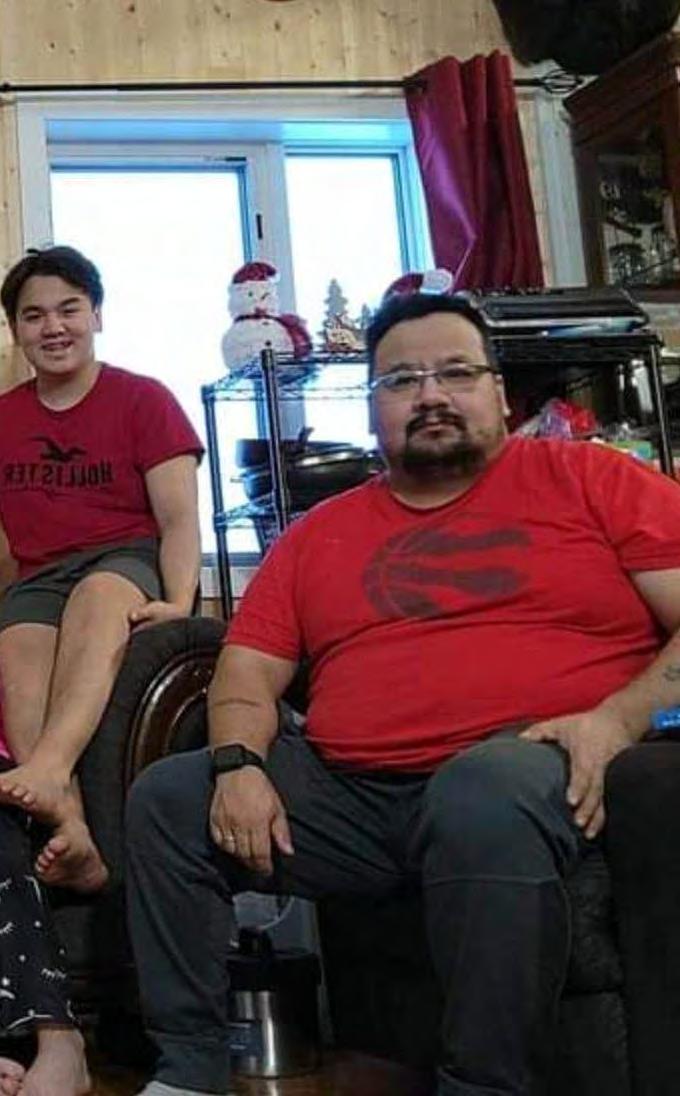
Hunter was diagnosed in September 2020 with a genetic kidney disease called juvenile nephronopthisis. For the most part, he has been able to live life regularly, still playing hockey and hunting, but he’s taking 10 pills a day to treat his condition and suffers from low energy levels at times.
The family put out public pleas for people to sign up to be kidney donors, as the process to approve a donor can take up to a year.
Daniel had a blood type match, but there was one problem.
“I was overweight,” said Daniel, 48, who at the time was 274 pounds. “Then I worked my ass off for the whole year.”
He lost 75 pounds over the past year, getting himself below 200 pounds. He accomplished it by exercising, watching what he ate and support from wife Francine.
And on his birthday this past March 15, on the first day of the Terence Tootoo hockey tournament as he and his son suited up for the same team, he got the official, final word from the doctors: he was approved to be Hunter’s kidney donor.
“I’m pumped up,” said Daniel. “I’m really, really happy for my son. I don’t care about myself, but as for my son, donating a kidney so he can be a regular teenager without having to take these 10 pills a day and stuff like that, while being active and an aggressive hockey player… I just can’t wait until his strife is over.”
When Daniel told Hunter the news, the teenager’s energy changed.
“His body language lifted up,” said Daniel.
“Happiest face I ever seen on him. That little laugh, smiling, glow in his face. That was his reaction. That was my, I guess, turning point of my hard work exercising. It paid off.”
The transplant is scheduled for June 22. Daniel will spend a couple weeks in the hospital, while Hunter may spend up to three months. The timing couldn’t be better, said Daniel, as hunting season is poor over the summer and Hunter should be coming back right in time for good hunting and hockey.
Daniel said he did it all for the love of his son.
“I was determined,” he said. “Lots of work,

lots of walking. Challenging at times mentally, but for the love of my son I just kept pushing myself, and it’s paying off now.”
For any other parents or family members in a similar situation, Daniel recommends the power of prayer and knowing that anything is possible if you put your mind and heart into it. Despite his kidney issues – and Daniel dislocating his shoulder during the hockey tournament – Eskimo Point earned silver in the B division of the 2023 Terence Tootoo Memorial.
“I’m looking forward to playing with him again in the future,” said Daniel.
Nunavut News kNKu W?9oxJ5 www.nunavutnews.com A4 Monday, April 3, 2023
Daniel Kablutsiak, right, lost 75 pounds over the past year to be able to donate one of his kidneys to son Hunter, left.
ᑖᓂᐅᓪ ᖃᑉᓗᑦᓯᐊᖅ,
ᑐᓂᓯᔪᓐᓇᕐᓂᕐᒧᑦ ᐊᑕᐅᓯᐅᔪᒥ
Photo courtesy of Daniel Kablutsiak
ᑕᓕᖅᐱᖕᒥ, ᓴᓗᒃᑎᓴᓚᐅᖅᐳᖅ 75 ᐸᐅᓐᓂ ᖄᖏᖅᓯᒪᔪᒥ ᐊᕐᕌᒎᔪᒥ
ᑕᖅᑐᖏᓐᓂ ᐃᕐᓂᖓᓄᑦ ᕼᐊᓐᑐᕐᒧᑦ, ᓴᐅᒥᖕᒥ.
Federal budget aligns with Nunavut priorities, but more funding needed Nunavut
government to continue to press for better healthcare; improved access to housing
By Trevor Wright Northern News Services Ottawa
The Government of Canada’s budget, announced on March 28, contributes positively toward Nunavut’s health woes and housing crisis, said Nunavut premier P.J. Akeeagok, but added they will continue to press for more investments.
“To achieve the transformative change in our government’s Katujjiluta mandate, significant investments from the federal government are needed. Today’s federal budget announcements contribute to our government’s efforts to improve access to housing and health care services here in Nunavut,” said Akeeagok.
“We will continue to press for federal commitments that will allow for nation-building investments that further social and economic reconciliation for our Inuit region.”
Deputy Prime Minister Chrystia Freeland, in her budget address, said inflation relief, more healthcare funding, a cleaner economy and lowering the deficit were the main goals of this year’s budget.

“Canada has made a remarkable recovery from the Covid recession,” wrote Freeland, later saying, “With these strong economic fundamentals, Budget 2023 comes at an important moment for our country - and at an important moment for the world.”
The Government of Nunavut outlined federal investments relevant to Nunavut and they
are as follows:
- $4 billion over seven years toward the national Urban, Rural and Northern Indigenous Housing Strategy;
- A five-year renewal of the Territorial Formula Financing, the main federal funding transfer for Nunavut;

- A 10-year renewal of the Territorial Health Investment Fund, a significant source for Nunavut health funds;
- $810.6 million over five years for non-insured health benefits, major source of funding for rural Indigenous dental, vision, mental health care, prescriptions and medical travel;

- $16.2 million to address tuberculosis in Inuit communities;
- $250 million over three years for an Oral Access Fund to help improve access to oral health and dental services in rural and remote communities.
There is also additional funding through the Canada Health Transfer and other bilateral health agreements according to Nunavut’s Department of Finance, however a specific amount was not listed.
Nunavut’s finance minister, Lorne Kusugak, echoed P.J. Akeeagok’s statement.
“We will continue to work with the federal government in securing housing and infrastructure funding that helps us build the Nunavut we envision in our Katujjiluta mandate - a territory of strong, healthy and prosperous communities where Nunavummiut can thrive,” he said.
ᑲᓇᑕᒥ ᑮᓇᐅᔭᑦ ᐊᑐᖅᑐᒃᓴᓂᒃ ᒪᓕᒐᓕᐅᕐᕕᒡᔪᐊᕐᒥ ᑲᓇᑕᐅᑉ ᒪᓕᒐᓕᐅᕐᕕᒡᔪᐊᖓᓂ ᐋᑐᕚᒥ, ᐊᐃᑉᐱᕐᒥ, ᒫᔾᔨ 28, 2023-ᒥ.
Nunavut News kNKu W?9oxJ5 www.nunavutnews.com A6 Monday, April 3, 2023
ᑲᓇᑕᐅᑉ
ᑐᒡᓕᐊ ᐊᒻᒪ ᒥᓂᔅᑕ ᑮᓇᐅᔭᓕᕆᔨᒃᑯᓐᓄᑦ ᓱᐃᑎᐊ ᕗᕇᓚᓐ ᓴᖅᑭᑦᑎᕗᑦ
Deputy Prime Minister and Minister of Finance Chrystia Freeland delivers the federal budget in the House of Commons on Parliament Hill in Ottawa, Tuesday, March 28, 2023. The Canadian Press/Sean Kilpatrick
ᐊᖓᔪᖅᑳᕐᔪᐊᖓᑕ
ᓲᓐᓂᐅᒪᙱᑦᑐᒥ ᒫᔾᔨᐅᔪᒥ
ᓴᓇᐅᒐᓕᐅᕐᓂᕐᒥ
ᐃᓴᒃᓯᒪᒋᑦ ᐃᓘᓯᕐᒥ ᑲᑐᔾᔨᖃᑎᒌᒃᑯᑦ ᐊᑐᐃᓐᓇᖃᖅᑎᑦᑎᕗᖅ ᐃᓂᐅᔪᒥ ᑲᑎᕝᕕᒃᓴᐅᔪᒥ
ᕼᐊᐃᓕ ᐅᐊᐃᑦ, ᑭᕙᓪᓕᕐᒥ ᐱᓕᕆᐊᖑᔪᒧᑦ ᐱᓕᕆᔨᐅᔪᖅ ᐃᓴᒃᓯᒪᒋᑦ ᐃᓘᓯᕐᒥ ᑲᑐᔾᔨᖃᑎᒌᒃᑯᓐᓂ, ᐅᖃᓚᐅᖅᐳᖅ ᐅᓄᕐᓂᖅᓴᐅᔪᓂ 150−ᓂ ᐃᓄᖕᓂ ᑎᑎᕋᕐᕕᖓᒎᖅᓯᒪᕗᑦ ᒫᔾᔨᒥ ᓱᓐᓂᐅᒪᙱᓪᓗᓂ
ᑕᖅᑭᐅᔪᒥ ᖃᓄᐃᓕᐅᕐᓂᐅᔪᓄᑦ.
Haley White, Kivalliq program co-ordinator with Embrace Life Council, said more than 150 people have come through her office during March sobriety month activities. Stewart Burnett/NNSL
By Stewart Burnett Northern News Services
ᐱᕈᖅᓴᓯᒪᓪᓗᓂ ᑲᖏᖅᖠᓂᕐᒥ, ᕼᐊᐃᓕ ᐅᐊᐃᑦ ᑕᑯᓯᒪᕗᖅ ᐊᓯᔾᔨᕐᓂᐅᔪᓂ ᓄᓇᓕᖕᓂ ᑕᐃᒪᙵᓂ ᒪᑐᐃᖅᑕᐅᓚᐅᕐᓂᖓᓂ ᐱᐊᒥ ᐊᒻᒪ ᕙᐃᓂᒥ ᓂᐅᕕᕐᕕᖓᓂ 2021−ᒥ. “ᑕᑯᓯᒪᕐᔪᐊᖅᐳᖓ ᐱᐅᙱᓐᓂᖅᓴᐅᔪᒥ ᐊᓯᔾᔨᕐᓂᐅᔪᒥ ᓄᓇᓕᑦᑎᓐᓂ,” ᐅᖃᓚᐅᖅᐳᖅ ᐅᐊᐃᑦ, ᑭᕙᓪᓕᕐᒥ ᐱᓕᕆᐊᖑᔪᒧᑦ ᐱᓕᕆᔨᐅᔪᖅ ᐃᓴᒃᓯᒪᒋᑦ ᐃᓘᓯᕐᒥ ᑲᑐᔾᔨᖃᑎᒌᒃᑯᓐᓂ. “ᑕᑯᓯᒪᕗᖓ ᖃᓄᖅ ᐊᒃᑐᐃᕙᖕᓂᖓᓂ ᓄᓇᖃᖅᑎᐅᔪᓂ ᓄᓇᓕᖕᓂ.
ᓄᓇᒥ ᐊᒻᒪ ᐃᓱᒫᓘᑕᐅᔪᓂ ᐋᖓᔮᖅᑐᓄᑦ ᐃᓄᖕᓂ ᐊᖏᕐᕋᐅᕙᓪᓕᐊᓪᓗᑎᒃ
ᐱᐅᙱᑦᑐᒥ ᐊᓯᔾᔨᕐᓂᐅᔪᒥ. ᑭᓯᐊᓂ ᐃᓱᐊᓂ, ᐅᐊᐃᑦ ᐊᑐᓚᐅᖅᐳᖅ ᒫᔾᔨᒥ ᕙᖅᓴᐃᓂᕐᒧᑦ ᓱᓐᓂᐅᒪᙱᓐᓂᕐᒥ ᐊᒻᒪ ᐱᐅᔪᒥ, ᐃᓚᒌᓄᑦ−ᑐᙵᓇᖅᑐᒥ ᖃᓄᐃᓕᐅᕐᓂᐅᔪᓂ ᐅᕘᓇ ᐃᓴᒃᓯᒪᒋᑦ ᐃᓘᓯᕐᒥ ᑲᑐᔾᔨᖃᑎᒌᒃᑎᒍᑦ. ᐱᓇᓱᐊᕈᓯᑕᒫᑦ, ᓄᓇᖃᖅᑎᐅᔪᑦ ᐊᐃᒃᓯᕈᓐᓇᖅᐳᑦ ᐊᓯᔾᔨᖅᐸᓪᓕᐊᔪᓂ ᓴᓇᐅᒐᓕᕐᓂᕐᒧᑦ ᑲᑎᙵᓂᐅᔪᓂ – ᐃᓇᖏᑦ ᑎᑎᕋᐅᔭᕐᓂᕐᒧᑦ, ᐳᐊᓗᓕᐅᕐᓂᕐᒥ ᐊᒻᒪ ᐊᒥᓱᒃᑲᓐᓂᕐᓂ – ᐊᒻᒪ ᐃᓴᒃᓯᒪᒋᑦ ᐃᓘᓯᕐᒥ ᑲᑐᔾᔨᖃᑎᒌᒃᑯᑦ ᑎᑎᕋᕐᕕᖓᓃᓪᓗᑎᒃ ᐃᓅᖃᑎᒌᖏᓐᓂ, ᓴᓇᐅᒐᓕᐅᕈᓘᔭᕐᓗᑎᒃ ᐊᒻᒪ ᐊᑦᑕᓇᙱᑦᑐᒥ ᐃᓂᒃᓴᖃᕐᓗᑎᒃ ᑲᑎᓐᓂᕐᒧᑦ. ᐃᓯᖅᑎᑕᐅᓚᐅᕆᕗᑦ ᐊᒧᔭᐅᓂᐅᔪᓄᑦ ᓵᓚᖃᐅᓯᐊᓄᑦ ᓲᕐᓗ ᑳᓪᒻ ᐃᐊᕐᒥ ᖃᖓᑦᑕᐅᑎᒃᓴᓂ ᐊᒻᒪ ᖃᓪᓗᓈᖅᑕᓂ ᑲᑎᙵᓂᐅᔪᓂ. “ᑭᒃᑯᓕᒫᑦ ᐱᐅᔪᓂ ᐅᖃᐅᓯᒃᓴᓕᐅᖅᓯᒪᕗᑦ,” ᐅᖃᓚᐅᖅᐳᖅ ᐅᐊᐃᑦ. “ᐱᐅᓪᓗᓂ, ᐊᑲᐅᓪᓗᓂ ᐃᒃᐱᒍᓱᖕᓇᕐᓂᐅᕗᖅ. ᓄᓇᖃᖅᑎᐅᔪᑦ ᐃᒪᐃᓕᕗᑦ, ‘ᐄ, ᑕᐃᒪᐃᓕᐅᖏᓐᓇᓪᖢᐊᖅᐳᓯ, ᑲᒪᓇᖅᑐᐊᓗᒃ, ᐅᕙᑦᑎᓐᓂ
A sober March of crafts
Embrace Life Council offers place to gather
By Stewart Burnett Northern News Services Rankin Inlet Local Journalism Initiative
Raised in Rankin Inlet, Haley White has seen changes in the community since the opening of the beer and wine store in 2021.
“I have definitely seen a more negative change in our community,” said White, program co-ordinator at Embrace Life Council. “I have seen how it affects the residents of my community. It’s really heartbreaking.”
Beer cans on the land and worries for intoxicated people navigating their way home in poor conditions have been part of that negative change.
But on her end, White used March to promote sobriety and positive, family-friendly activities through Embrace Life Council.
Each week, residents could pick up changing craft kits –some for print making, mitt making and more – and hang out at the Embrace Life Council office to socialize, craft around and have a safe place to gather. They were also entered into draws for prizes like Calm Air tickets and material bundles.

“Everybody has given such positive feedback,” said White. “It’s a nice, pleasant feeling. The residents are like, ‘Yeah, you should keep doing this, it’s amazing, it’s keeping us active, keeping us busy.’”
She’s hoping to get more feedback as the month comes to a close about what to improve and alter for next time. One thing she knows she wants to continue is keeping her office open into the evening for drop-ins.
“I’m super proud of the participants,” said White. “They’re doing so amazing. It’s – I don’t want to say amazing again – it’s so amazing seeing people come in, and their children are allowed to come in to be with them. We have a lot of art supplies, we have games, puzzles, everything you need to come and enjoy a nice relaxing evening, afternoon or morning.”
ᐱᓕᕆᑎᑦᑎᓇᖅᑐᖅ, ᐱᔭᒃᓴᖃᐃᓐᓇᖅᑎᑦᑎᓪᓗᓂ.’”
ᓂᕆᐅᒃᐳᖅ ᐱᒃᑲᓐᓂᕐᓂᐊᕐᓂᖓᓂ ᐅᖃᐅᓯᒃᓴᓕᖓᖑᔪᓂ ᑕᖅᑭᖅ ᐃᓱᓕᑉᐸᓪᓕᐊᑎᓪᓗᒍ ᑭᓱᓂᒃ ᐱᐅᓯᒋᐊᖅᑕᐅᔪᓐᓇᕐᓂᖏᓐᓂ ᐊᒻᒪ ᐊᓯᔾᔨᖅᑕᐅᓗᓂ ᑭᖑᓪᓕᐅᔪᒧᑦ. ᐊᑕᐅᓯᖅ ᖃᐅᔨᒪᔭᖓᓐᓂ ᑎᑎᕋᕐᕕᖓᓂ ᒪᑐᐃᖓᑎᑦᑏᓐᓇᕐᓂᕐᒥ ᐅᓐᓄᖓᓄᑦ ᐅᐸᒃᑕᐅᕝᕕᒃᓴᐅᓗᓂ.
“ᐃᓚᐅᖃᑕᐅᔪᓂ ᐅᐱᒋᕐᔪᐊᖅᐸᒃᑲ,” ᐅᖃᓚᐅᖅᐳᖅ ᐅᐊᐃᑦ. “ᑲᒪᓇᖅᑐᒥ ᐱᓕᕆᕗᑦ. ᐃᒪᐃᑉᐳᖅ− ᐅᖃᒃᑲᓐᓂᕈᒪᙱᓚᖓ ᑲᒪᓇᖅᑐᖅ– ᐅᐊᑲᓪᓚᐅᕗᖅ ᑕᑯᓪᓗᓂ ᐃᓄᖕᓂ ᐃᓯᖅᑐᓂ, ᐊᒻᒪ ᕿᑐᕐᙵᖏᑦ ᐃᓯᖃᑕᐅᔪᓐᓇᖅᖢᑎᒃ. ᐊᒥᓱᐊᓗᖕᓂ ᑎᑎᕋᐅᔭᒐᒃᓴᐅᔪᓂ ᓱᓇᒃᑯᑖᖃᖅᐳᒍᑦ, ᐱᙳᐊᕈᑎᖃᖅᐳᒍᑦ, ᐋᖅᑭᒃᓱᒐᕐᓂ, ᑭᓱᑐᐃᓐᓇᓂ ᐱᔭᕆᐊᓕᖕᓂ ᖃᐃᑎᑦᑎᓂᕐᒧᑦ ᐊᓐ, ᐊᓕᐊᓇᐃᒍᓱᒡᓗᑎᒃ ᖃᓱᖓᑦᑎᐊᕐᓗᑎᒃ ᐅᓐᓅᔪᒥ, ᐅᓐᓄᓴᒥ ᐅᓪᓛᒃᑯᓪᓘᓐᓃᑦ.”
ᑎᑎᕋᕐᕕᖓ ᒪᑐᐃᖓᑎᑲᑕᒃᐸᖓ ᑭᓯᐊᓂ 9−ᒥ ᐅᕝᕙᓘᓐᓃᑦ 10−ᒧᑦ ᐅᓐᓄᒃᑯᑦ ᑕᒪᕐᒥᒐᓚᒃ ᐅᓐᓄᖕᓂ ᐃᓄᖕᓄᑦ ᐃᓯᓚᐅᑲᒍᓐᓇᙱᑦᑐᓄᑦ
ᐃᖅᑲᓇᐃᔭᕐᓇᐅᑎᓪᓗᒍ ᐃᑲᕐᕋᖏᓐᓂ. ᐱᖓᔪᖓᓐᓂ ᐱᓇᓱᐊᕈᓯᖓᓐᓂ, ᐅᓄᕐᓂᖅᓴᐅᔪᓂ 150−ᓂ people ᑕᐃᑯᙵᖅᓯᒪᕗᑦ ᐱᓕᕆᐊᖑᓂᐅᔪᓄᑦ, ᐅᖃᓚᐅᖅᐳᖅ ᐅᐊᐃᑦ.
ᒫᔾᔨᒥ ᓱᓐᓂᐅᒪᙱᓐᓂᐅᔪᒥ ᑕᖅᑭᖓ ᓄᖅᑲᖅᐸᓪᓕᐊᓕᖅᑎᓪᓗᒍ, ᐃᓴᒃᓯᒪᒋᑦ ᐃᓘᓯᕐᒥ ᑲᑐᔾᔨᖃᑎᒌᒃᑯᑦ ᐱᓇᓱᐊᖏᓐᓇᖅᐳᑦ ᐃᒻᒥᓃᖅᑎᑦᑕᐃᓕᒪᓂᐅᔪᒥ ᑐᕌᒐᒃᓴᖓᓂ ᐅᕘᓇ ᐊᔾᔨᒌᙱᑦᑑᑕᐅᔪᓂ ᐃᓕᓐᓂᐊᖅᑎᑦᑎᓂᐅᔪᓂ, ᐱᒋᐊᕈᑕᐅᔪᓂ ᐊᒻᒪ ᐱᓕᕆᐊᖑᔪᓂ. “ᐊᐅᓚᑦᑎᔪᒪᕗᒍᑦ ᐱᓕᕆᐊᖑᒧᓂ ᓄᓇᕗᒻᒥᐅᑕᐅᔪᓄᑦ ᓄᖅᑲᖅᑎᑦᑎᓂᕐᒧᑦ ᐃᒻᒥᓃᕐᓂᐅᔪᒥ ᐊᒻᒪ ᖁᕝᕙᖅᓴᐃᓗᑎᒃ ᐱᐅᔪᒥ ᐃᓱᒪᒧᑦ ᐋᓐᓂᐊᖃᕐᓇᙱᑦᑐᓕᕆᓂᕐᒥ ᐊᒻᒪ ᐃᓱᒪᒧᑦ ᖃᓄᐃᙱᑦᑎᐊᕐᓂᐅᔪᒥ,”
ᑲᖏᖅᖠᓂᕐᒥ ᑎᑎᕋᕐᕕᖓᓂ ᒫᔾᔨᒥ ᓱᓐᓂᐅᒪᙱᓐᓂᕐᒥ ᑕᖅᑭᐅᔪᒥ ᖃᓄᐃᓕᐅᕐᓂᐅᔪᓂ.
She’s been keeping the office open until 9 or 10 p.m. on drop-in nights for people who can’t visit during regular work hours. By the third week of March, more than 150 people had come through for the program, said White.
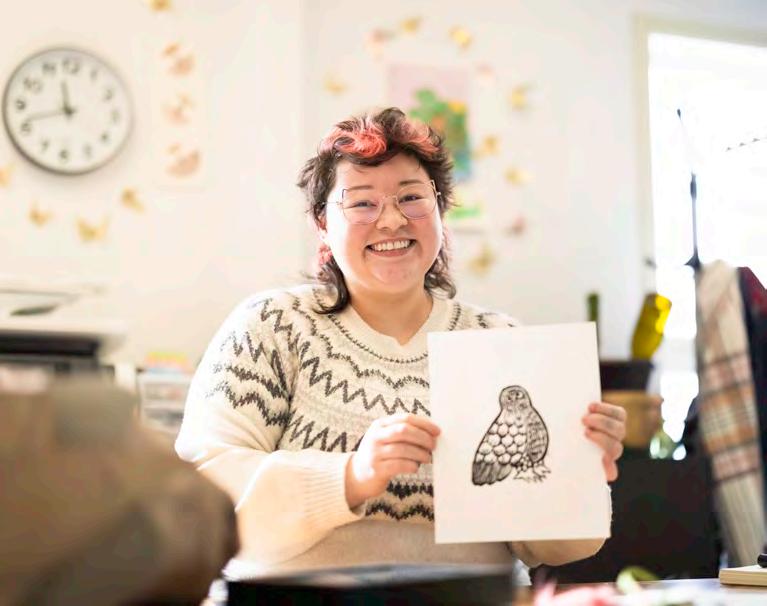
As the March sobriety month comes to a close, Embrace Life
Council continues pursuing its anti-suicide mission through a variety of workshops, initiatives and programs. “We want to run programs for the residents of Nunavut to prevent suicide and promote good mental health and mental wellness,” said White.
Nunavut News kNKu W?9oxJ5 Monday, April 3, 2023 A7 www.nunavutnews.com
ᐆᒻᒪᑎᒧᑦ ᓱᕋᖕᓇᑦᑎᐊᖅᑐᖅ.” ᐱᐊᖃᐅᑎᓂ
ᓯᓚᑦᑎᐊᕙᐅᙱᑦᑐᒥ ᐃᓚᒋᔭᐅᓯᒪᕗᖅ
ᐅᖃᓚᐅᖅᐳᖅ ᐅᐊᐃᑦ.
photo
ᕼᐊᐃᓕ ᐅᐊᐃᑦ, ᑭᕙᓪᓕᕐᒥ ᐱᓕᕆᐊᖑᔪᒧᑦ ᐱᓕᕆᔨᐅᔪᖅ ᐃᓴᒃᓯᒪᒋᑦ ᐃᓘᓯᕐᒥ ᑲᑐᔾᔨᖃᑎᒌᒃᑯᓐᓄᑦ, ᑎᒍᒥᐊᖅᐳᖅ ᐃᓚᖏᓐᓂ ᓴᓇᐅᒐᓂ ᐊᑐᐃᓐᓇᐅᔪᓂ
Haley White, Kivalliq program coordinator with Embrace Life Council, holds up some of the crafts available at her Rankin Inlet office during the March sobriety month of activities. Stewart Burnett/NNSL photo
The bright future of solar in Nunavut Renewable energy support for cabins a popular program
impact on reducing diesel power use.
The future of solar power in Nunavut is bright, said the president of the Arctic Renewables Society.
The non-profit, founded in 2019, had the opportunity to showcase the various renewable energy projects in Iqaluit to visiting delegates from other communities during the Qikiqtani Energy Forum.
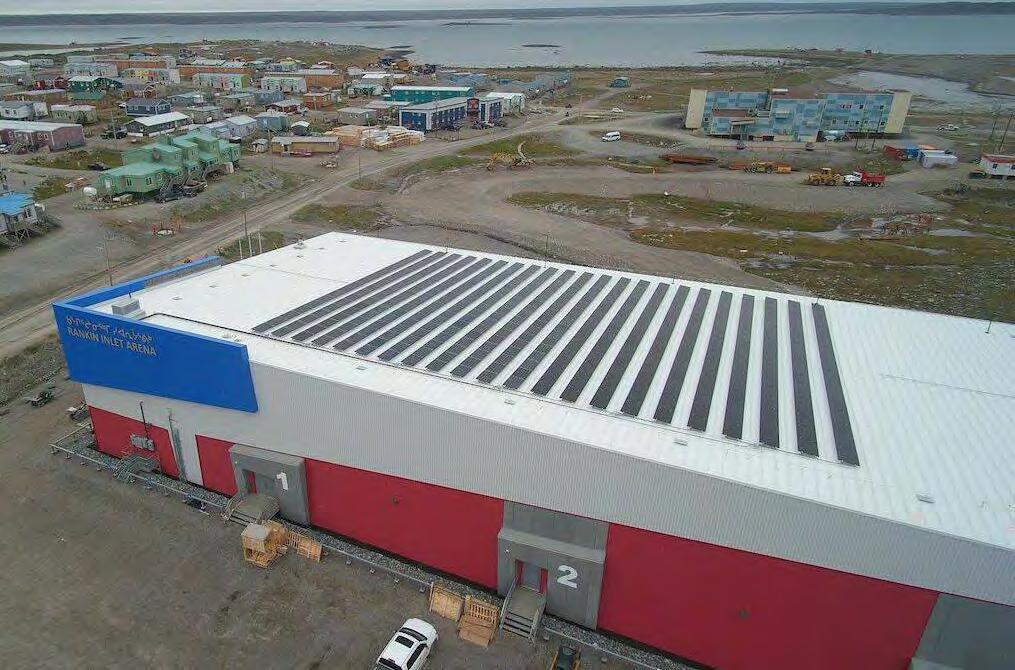
“They had no idea there was so much (solar) in the community,” said Martha Lenio, president of the Arctic Renewables Society, speaking to how Nunavut Arctic College buildings, the Arctic Winter Games Arena, the Aqsarniit Hotel and various houses in Iqaluit save money while helping the environment by adopting solar.
An average homeowner’s utility bill (with solar) ranges from less than $1,000 to not paying at all during the summer, according to the society.
Other communities with solar projects planned in or around Nunavut include placing solar panel systems on arenas in Whale Cove, Pond Inlet, Arctic Bay and Clyde River, which have recently received federal funding.
There are also currently renewable energy feasibility studies being done Sanirajak and Sanikiluaq, the latter being a study on the possibility of wind and battery.
As more buildings in the territory place solar panels on its rooftops, it will have a broader and broader
“As you get more solar onto the grid, you do need to add things like energy storage. We’ll get higher and higher grid penetration, 40, 50 or 60 per cent of your energy could be coming from a nice sunny day,” said Lenio.
Solar power on rooftops in countries such as Australia “provides more power to the grid now than coal” and has the ability to change Nunavut’s energy landscape.
Additional grid controls, such as being able to turn solar panels off would also be needed when Nunavut reaches the point where the majority of its energy comes from renewables.
Current policies
While the Qulliq Energy Corporation operates diesel plants in all 25 communities, QEC has also begun several policies to support renewable energy. This includes its net-metering program, which provides solar power to the grid if a home with panels produces more power than it is consuming.
Another is the Commercial Institutional Power Producer program, allowing for larger renewable energy installations on commercial or institutional buildings like businesses and government buildings like schools.
The latest policy currently in the works is the Independent Power Producer program, which is expected to help pave the way for larger renewable energy projects in the territory like wind farms and larger solar panel installations.
The most popular renewable energy program by far, Lenio adds, is actually run by Nunavut’s Climate Change Secretariat under the Department of Environment: the Renewable Energy Cabin Grant, which is a one-time grant of up to $5,000 to allow people to install solar panels on their cabins.
“They spend their whole budget allocation every year,” she said, with Rankin Inlet and Kugluktu leading the way in getting people to utilize solar on their cabins.
“They have local people who are real advocates for solar and know
how to size and install these off-grid systems.”
It’s a program the Arctic Renewable Society itself is keen on promoting, holding training in Iqaluit showing people how to install solar panels on cabins. Lenio says people at the time were very interested in learning more.
Home energy audit training is also another job the society does, helping homeowners identify opportunities for retrofits and how to improve a home’s energy efficiency. A home energy audit helps save money and the environment, but it also assists in
accessing federal funding for promoting green home energy renovations. While there are many solar projects going on around Nunavut at this time, Lenio adds it still needs to be used in conjunction with other renewables as well as energy storage before we could wean ourselves off diesel, particularly in Northern Nunavut communities like Resolute Bay and Grise Fiord.
“It’s very dark in the winter, some communities don’t get sun at all for over a month in the winter. Solar’s not going to be the whole solution.”
Lost Franklin Expedition ships to become Nunavut’s first national historic
sites
Federal government announces $23 million to go toward sites
for Parks Canada Steven Guilbeault. The federal announcement also touted economic benefits for the communities of Gjoa Haven and Cambridge Bay.
National Inuit-led historic sites are to be established near the wrecks of the HMS Erebus and HMS Terror, where the famous Franklin Expedition ships got stuck in the ice in 1846.
This is thanks to a $23 million ten-year Inuit Impact and Benefit Agreement the federal government signed with the Kitikmeot Inuit Association in March.
The Kitikmeot Inuit Association and the Nattilik Heritage Society in Gjoa Haven will be receiving the funding and will be cooperating with Parks Canada to manage and operate the sites, giving advice on site management. Inuit will also take part in on-site interpretation as to how expedition members might have interacted with Inuit over 170 years ago.
“Now, with the signing of this progressive and innovative agreement, the Kitikmeot Inuit will secure the ongoing conservation and management of the Wrecks of HMS Erebus and HMS Terror National Historic Site,” said federal environment and climate change minister and minister responsible
Under the Nunavut Agreement, an Inuit Impact and Benefit Agreement must be negotiated with a designated Inuit organization before establishing any protected areas within Nunavut.
“The establishment of this first operational national historic site of Canada in Nunavut will share the story of the Franklin Expedition and the fate of its sailors across Canada and internationally,” said Robert Greenley, president of the Kitikmeot Inuit Association, adding it both serve as a window to the past and be a gateway for tourism.
“I am extremely pleased to have been part of the signing of this historic agreement.”
The first wreck of the Franklin Expedition, HMS Erebus, was discovered in 2014 in Wilmot and Crompton Bay. Two years later the HMS Terror was located, in Terror Bay.
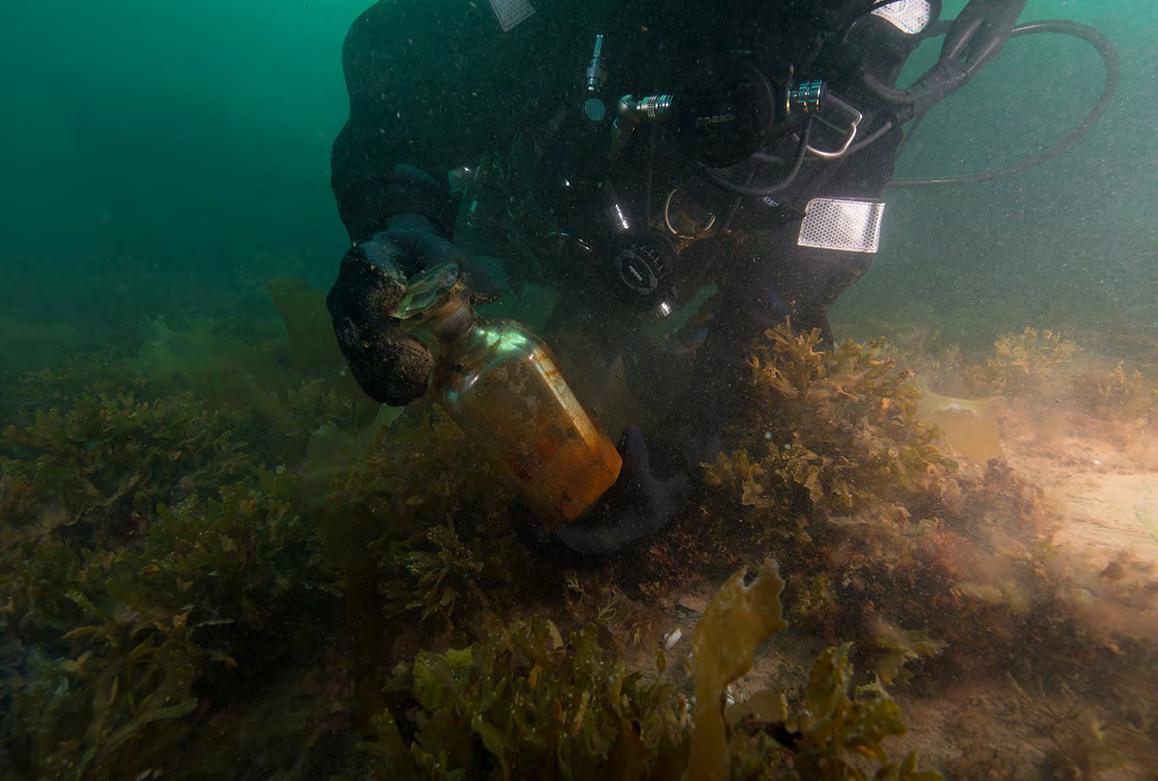
On-site archaeological efforts were paused due to the Covid-19 pandemic in 2020 and resumed in May 2022.
The HMS Erebus is named after the ancient Greek deity of darkness, the offspring of Chaos.
Nunavut News kNKu W?9oxJ5 Monday, April 3, 2023 A9 www.nunavutnews.com
Parks Canada diver Brandy Lockhart picks up a decanter bottle recovered from the HMS Erebus during a dive in August of 2019. The Kitikmeot Inuit Association and Nattilik Heritage Centre will be cooperating with Parks Canada to establish a national historic site where the Franklin Expedition ships got stuck in the ice. (Charles Dagneau, Parks Canada)
ᐱᓕᕆᔾᔪᓯᐅᔪᒥ ᖄᖓᓂ ᐊᒡᓂᑯ ᐄᒍᓪ ᐊᓐᓂᑭᑕᕐᕕᖓᓂ, ᐃᓕᔭᐅᔪᒥ 2021−ᒥ. ᐅᑭᐅᖅᑕᖅᑐᒥ ᓄᓇᒥᙶᖅᑐᒥ ᑲᑐᔾᔨᖃᑎᒌᖑᔪᓂ ᐅᖃᖅᐳᖅ ᐃᓕᓯᒃᑲᓐᓂᕐᓂᕐᒥ ᐅᓄᕐᓂᖅᓴᐅᔪᓂ ᓯᕿᓂᕐᒥ ᐆᒻᒪᖅᑯᑎᓕᐅᕈᑎᓂ ᐃᒡᓘᑉ ᖄᖓᓂ ᐊᖏᔪᒥ ᒥᒃᖠᒋᐊᖅᓯᔪᓐᓇᖅᐳᖅ ᐊᖏᓂᐅᔪᒥ ᐅᖅᓱᐊᓗᑐᐃᓐᓇᕐᒨᖅᑐᓄᑦ ᓄᓇᕗᒻᒥ ᓄᓇᓕᐅᔪᑦ ᐊᑐᖅᐸᒃᑕᖏᓐᓂ.
ᑲᖏᖅᖠᓂᕐᒥ 110 kilowatt ᓯᕿᓂᕐᒧᑦ ᐆᒻᒪᖅᑯᑎᓕᐅᕈᑎᓂ
Rankin Inlet’s 110 kilowatt solar panel system on top of Agnico Eagle Arena, installed in 2021. The Arctic Renewables Society says placing more and more solar panels on top of buildings can broadly reduce the amount of diesel Nunavut communities consume. Photo courtesy of Green Sun Rising
By Trevor Wright Northern News Services
Kitikmeot By Trevor Wright Northern News Services Nunavut
ᐳᓈᕐᑦ ᒪᒃᑖᖅ ᓇᒃᓯᐅᔾᔨᓚᐅᖅᐳᖅ ᑖᔅᓱᒥᖓ ᐊᔾᔨᙳᐊᒥᒃ 7:30−ᒥ ᐅᓐᓄᒃᑯᑦ ᓯᕿᓂᖅ ᒥᑦᑎᒪᑕᓕᖕᒥ (ᒥᑦᑎᒪᑕᓕᖕᒥ).


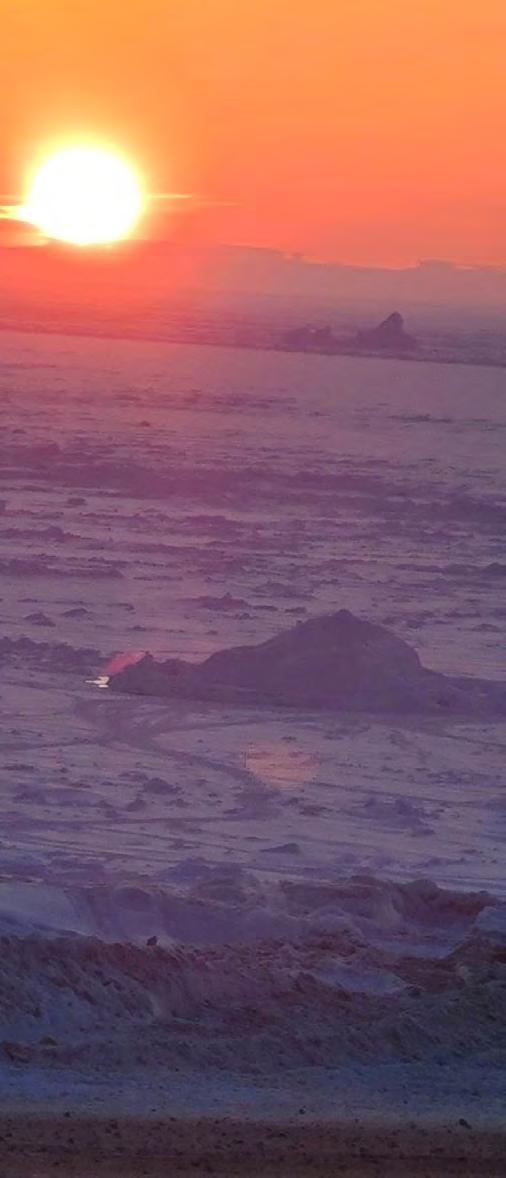

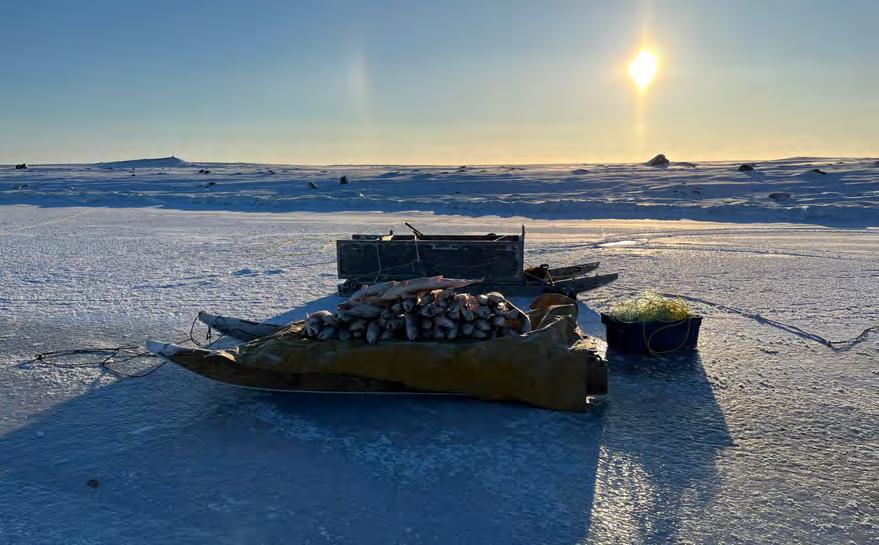
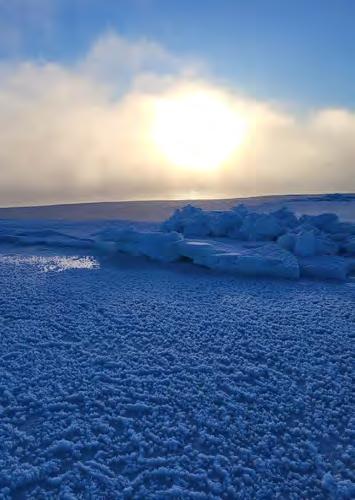
ᐊᔾᔨᓕᐅᖅᑕᐅᓪᓗᓂ ᒫᑦᓯ 15, 2023−ᒥ.
ᐊᔾᔨᒥᑦ ᑎᑭᕋᕐᔪᐊᒥᑦ ᐊᖑᓇᓱᒃᑕᖏᓐᓂᑦ ᓄᕕᐱᕆᒥᑦ. ᐱᔭᐅᔪᖅ ᖃᒪᓈᕐᔪᖕᒥ
ᔫᑕ ᓴᖅᐱᓇᖅ
Nunavut News kNKu W?9oxJ5 www.nunavutnews.com A10 Monday, April 3, 2023
Nunavut News presents the Amazing On-the-Land contest, generously sponsored by NCC Investment Group Inc., visit www.nccig.ca today. The post on our page with the most reactions each week will win $100. Send in your entry to Nunavut News by Facebook messaging.
ᑎᐅᕋᓐ ᐳᕉᔅ ᓇᒃᓯᐅᔾᔨᓚᐅᖅᑐᖅ ᐊᔾᔨᒥᑦ ᓴᓪᓕᓂᑦ, ᕕᕝᕗᐊᕆᐅᑉ ᐱᒋᐊᕐᓂᖓᓂᑦ ᑰᒃᐸᓪᓕᐊᑎᓪᓗᒍ. ᑐᐸ ᕗᐊᑦ ᓇᒃᓯᐅᔾᔨᕕᒋᓚᐅᖅᑖᑎᒍᑦ
ᑎᑭᕋᕐᔪᐊᑉ ᓯᓚᑖᓂ. Tupa Ford sent us this image from Whale Cove of their harvest in November. Taken at Qamanaarjuk just outside Whale Cove. ᔪᐊᓐ ᓄᓐᖓᖅ ᓇᒃᓯᐅᔾᔨᓚᐅᖅᐳᖅ ᑖᔅᓱᒥᖓ
ᕗᐊᑦᒥᑦ,
Darren Bruce sent us this image from Coral Harbour, taken in early February at the flow edge.
ᐊᔾᔨᙳᐊᒥᒃ ᐊᐅᓱᐃᑦᑐᒥᑦ
Joanie Nungaq sent us this image of the sun on the horizon in Grise Ford, taken on March 15, 2023.
Bernard Maktaaq sent us this image of a 7:30 p.m. sunset in Mittimatalik (Pond Inlet).
ᓇᒃᓯᐅᔾᔨᓚᐅᖅᐳᖅ ᐊᔾᔨᒥᑦ ᕿᑭᖅᑖᓗᖕᒥᑦ ᐃᖃᓗᒐᓱᒃᑐᓂᑦ ᒫᑦᓯ 17, 2023− ᒥᑦ ᓯᓚᑦᑎᐊᕙᐅᓪᓗᓂ.
ᓵᓚᖃᖅᑐᖅ! ᐋᔅᑯᕐ ᑖᓐ ᑳᒧᕐ ᓇᒃᓯᐅᔾᔨᓚᐅᖅᐳᖅ ᑖᔅᓱᒥᖓ ᐊᔾᔨᙳᐊᒥᒃ ᑲᖏᖅᖠᓂᕐᒥᙶᖅᑐᒥᒃ ᑲᒪᓇᑦᑎᐊᖅᑐᒥᒃ ᐊᕉᕋ ᐊᖑᓇᓱᖕᓂᕐᒥᒃ, ᐱᔭᐅᓪᓗᓂ ᒫᑦᓯ 23, 2023−ᒥ.
Juuta Sarpinak sent us this image from Baffin Island of fishing on March 17, 2023 with beautiful weather.
KINDLY SPONSORED BY INVESTMENT
WINNER! Oscar Tan Camano sent us this image from Rankin Inlet of an amazing aurora hunting, taken on March 23, 2023.
GROUP INC.
National Inuit organization seeking $1.6 billion for school food program
A national Inuit organization is calling for about $1.6 billion in federal funding over 15 years to set up a co-ordinated school food program in the North.
Inuit Tapiriit Kanatami released a report last week, developed through the Inuit-Crown Food Security Working Group, advocating for a breakfast and lunch program in 75 schools across Inuit Nunangat, or Inuit homeland in Canada. Inuit Nunangat encompasses 51 communities in the Northwest Territories, Nunavut, northern Quebec and northern Labrador, where the cost of living is high and food insecurity and poverty are prevalent.
“Ensuring that Inuit children and youth have what they need to eat and sustain themselves not only enhances their educational experience, it also ensures their mental wellness, their connection to Inuit culture and their overall security,” said Kiana Foster, a senior policy adviser with Inuit Tapiriit Kanatami.
“By feeding our children and youth, we are ensuring that they grow up to be healthy adults. It’s a true investment in our community and our people.”
Inuit Tapiriit Kanatami said the program should include long-term funding in human resources and infrastructure, focus on healthy and locally sourced food options, be able to to adapt to regional and community needs, and be grounded in Inuit culture.
The report details projected costs of the program from 2023 to 2038, taking into account anticipated school enrolment and attendance rates, as well as the cost of food, labour, training, operations and infrastructure. It states infrastructure will cost $102.4 million over the first three years, which includes building new or retrofitting existing kitchens in schools, while operating costs will be roughly $1.55 billion over 15 years.
Foster said food programming in various stages is currently being offered in some schools in Inuit Nunangat but they are largely run by teachers and principals. Many rely on donations, which she said is not sustainable.
Jason Rochon helped run the school food bank and breakfast program at Joamie Ilinniarvik School in Iqaluit, where he worked as a student support worker.
“Kids were helping each other fill their backpacks
and telling each other what to grab or if there were new items,” he said. “It was really, really nice.”
When schools in Iqaluit were closed due to the Covid19 pandemic, Rochon said volunteers began packing paper bags with breakfast items that included milk, cereal, cheese, yogurt and fruit, and distributed them to residents throughout the city. He said they would sometimes serve up to 600 people a day.
“We definitely see the need,” he said. “Any chance we get to feed children, we should make sure that we do that.”
Rochon said he was consulted about Inuit Tapiriit Kanatami’s proposed school food program and supports it.
He said finding adequate funding for food programming can be challenging as well as accessing fresh fruits, vegetables and dairy in the North where costs are high. He added it can be hard for school staff to find the time to run food programs alongside addressing academic and other student needs.
“Children who are well fed and have lots of rest, they learn, and you know you can’t teach a child if they’re hungry,” he said.
“We live in a country where children should have access to food. No kid should be going hungry and we all have a part to play.”
In Nunavik in northern Quebec, the regional board of health and social services said breakfast programs have been run in all schools for many years. In the past two
years, there has been a focus on developing lunch and snack programs.
This year, the board said it provided more than $600,000 to support school food programs and has seen an increase in requests for hot lunch programs in the up -
coming school year. It said it aims to secure long-term, stable funding for school food programs.

A 2007-08 Inuit Health Survey found 69 per cent of Inuit households in Nunavut were food insecure, 46 per cent in Nunatsiavut in north-
ᕿᑐᕐᖓᕗᑦ ᒪᒃᑯᒃᑐᕗᓪᓗ ᓂᕆᑎᑉᐸᒃᑕᕗᑦ, ᖃᐅᔨᒪᑦᑎᐊᕋᓱᒃᐳᒍᑦ ᐃᓐᓇᕈᑦᑎᐊᖁᓪᓗᒋᑦ. ᑕᒪᓐᓇ ᓱᓕᓪᓗᓂ ᑮᓇᐅᔭᓕᐅᕈᑕᐅᓇᓱᐊᖅᐳᖅ ᓄᓇᑦᑎᓐᓂ ᐃᓄᖁᑎᕗᓪᓗ. ᐅᖃᖅᑐᖅ ᑭᐊᓇ ᕙᔅᑐ, ᐃᓄᐃᑦ ᑕᐱᕇᑦ ᑲᓇᑕᒥ ᐊᑐᐊᒐᓕᕆᔨᒻᒪᕆᖓ.

“By feeding our children and youth, we are ensuring that they grow up to be healthy adults. It’s a true investment in our community and our people.” says Kiana Foster, Inuit Tapiriit Kanatami’s senior policy adviser. Stock photo
ern Labrador, and 43 per cent in the Inuvialuit Settlement Region in NWT and Yukon.


A 2014 survey on Inuit food security in Nunatsiavut found more than 59 per cent of households were food insecure, while a 2017 survey on Inuit health in Nunavik
found up to 78 per cent of respondents 16 years and older were food insecure.
— By Emily Blake, The Canadian Press. This story was produced with the financial assistance of the Meta and Canadian Press News Fellowship.
Nunavut News kNKu W?9oxJ5 Monday, April 3, 2023 A13 www.nunavutnews.com
‘By feeding our children and youth, we are ensuring that they grow up to be healthy adults,’ says policy adviser
ᐊᑎᓕᐅᖅᓯᒪᔪᓂ
By Stewart Burnett Northern News Services Local Journalism Initiaitive Chesterfield Inlet

23−ᖑᔪᓂ ᓄᓇᖃᖅᑎᐅᔪᓂ ᐊᑎᓕᐅᕆᓚᐅᖅᐳᑦ ᐊᑎᓕᐅᖅᓯᒪᔪᓂ
ᑐᒃᓯᕋᐅᒻᒥ ᓴᓇᓂᕐᒥ ᐊᑦᑕᓇᙱᑦᑐᒥ ᐃᓂᒃᓴᐅᔪᒥ ᐃᒡᓗᓕᒑᕐᔪᒃᖕᒥ
ᐃᓂᒃᓴᐅᔪᒥ ᐃᓄᐃᑦ ᐅᐸᒍᓐᓇᕐᓂᖏᓐᓂ ᑲᑉᐱᐊᓇᖅᑐᒃᑰᖅᑎᓪᓗᒋᑦ ᐊᒻᒪ
ᐊᓯᖓᓐᓂ ᓂᕈᐊᒐᒃᓴᖃᙱᓐᓂᖓᓂ.

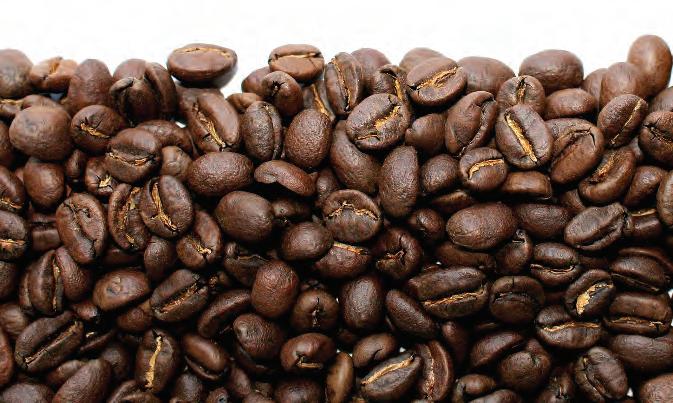
ᐊᑎᓕᐅᖅᓯᒪᔪᓂ ᑐᒃᓯᕋᐅᒻᒥ ᐱᒋᐊᖅᑕᐅᓚᐅᖅᐳᖅ ᓵᓇ ᒪᓕᓐᔅᒧᑦ ᐊᒻᒪ ᓴᖅᑭᑎᑕᐅᓚᐅᖅᐳᖅ ᒪᓕᒐᓕᐅᕐᕕᖕᒥ ᕕᕗᐊᕆ 28−ᒥ ᑲᖏᖅᖠᓂᕐᒥ ᐅᐊᖕᓇᖓᓂ-ᐃᒡᓗᓕᒑᕐᔪᖕᒥ ᒪᓕᒐᓕᐅᖅᑎ ᐋᓕᒃᓵᓐᑐᕐ ᓴᒻᒧᖅᑐᕐᒧᑦ. “ᐃᒡᓗᓕᒑᕐᔪᒃ ᓄᓇᓕᑐᐊᖑᙱᓚᖅ ᐊᒃᓱᕈᖅᐸᒃᑐᓂ ᖃᓄᐃᓐᓂᐅᔪᓄᑦ
ᐃᓄᐃᑦ ᕿᒫᔭᕆᐊᖃᕐᓂᖏᓐᓂ ᐅᓗᕆᐊᓇᖅᑐᒥ ᐅᕝᕙᓘᓐᓃᑦ
ᖃᓄᐃᓐᓂᑦᑎᐊᕙᐅᙱᑦᑐᒥ ᖃᔅᓯᐊᕐᔪᖕᓄᑦ ᐃᑲᕐᕋᓄᑦ ᐅᓐᓄᖕᒥᓪᓘᓐᓃᑦ,”
ᐅᖃᓚᐅᖅᐳᖅ ᓴᒻᒧᖅᑐᖅ ᒪᓕᒐᓕᐅᕐᕕᖕᒥ ᒫᔾᔨ 6−ᒥ, ᐅᖃᐅᓯᖃᖅᖢᓂ
ᐊᐱᖅᑯᑕᐅᔪᓂ ᒫᒡᒍᓕᑦ ᓇᑲᓱᖕᒧᑦ, ᒥᓂᔅᑕᐅᔪᒥ ᐃᓄᓕᕆᔨᒃᑯᓐᓄᑦ.
ᐊᐱᕆᓚᐅᖅᐳᖅ ᓇᑲᓱᖕᒥ ᐅᓂᒃᑳᕆᓂᕐᒥ ᐃᑲᔪᖅᓱᐃᓂᐅᔪᒥ ᐱᓕᕆᕝᕕᖓ ᑐᓂᓯᕙᖕᓂᖓᓂ ᓄᓇᓕᐅᔪᓄᑦ ᒪᑐᐃᖅᓯᔪᒪᔪᓄᑦ ᐊᑦᑕᓇᙱᑦᑐᒥ ᐃᒡᓗᕐᔪᐊᖑᔪᒥ.
ᐃᓄᖕᓄᑦ ᑲᑉᐱᐊᓇᖅᑐᒃᑰᖅᑐᓂ ᐅᐸᒡᕕᒃᓴᖓᓂ
“ᐅᓇ ᐱᓗᐊᖅᑐᒥ ᐊᑑᑎᖃᑦᑎᐊᖅᑐᒥ ᐊᐱᖅᑯᑕᐅᕗᖅ, ᓇᓗᓇᐃᖅᓯᓪᓚᕆᒃᓯᒪᒐᑦᑕ ᐃᓚᖏᑦ ᓄᓇᓕᐅᔪᑦ ᓴᓇᓇᓱᐊᖅᑐᓂ ᓴᖅᑭᑎᑦᑎᓂᕐᒥ ᐅᕝᕙᓘᓐᓃᑦ ᐱᒋᐊᖅᑎᑦᑎᓂᕐᒥ ᐊᑦᑕᓇᙱᑦᑐᒥ ᐊᖏᕐᕋᐅᔪᒥ, ᕿᓚᒻᒥᐅᔪᒥ ᐊᑦᑕᓇᙱᑦᑐᒥ ᐃᓂᒃᓴᐅᔪᒥ ᐅᕝᕙᓘᓐᓃᑦ ᐊᑦᑕᓇᙱᑦᑐᒥ ᕿᒫᕕᐅᓗᓂ,” ᐅᖃᓚᐅᖅᐳᖅ ᓇᑲᓱᒃ ᑐᓵᔨᑎᒍᑦ ᑭᐅᓂᐅᔪᒥ, ᐃᓚᒋᐊᖅᓯᓪᓗᓂ ᑕᒪᒃᑭᒐᓚᑦ ᑎᒥᖁᑕᐅᔪᑦ ᑮᓇᐅᔭᓕᐅᕋᓱᐊᙱᖦᖢᑎᒃ ᑲᑐᔾᔨᖃᑎᒌᖑᕗᑦ ᐅᕝᕙᓘᓐᓃᑦ ᓄᓇᓕᖕᓂ ᕼᐋᒻᓚᒃᑯᓐᓂ ᐱᒋᐊᖅᑎᑦᑎᓯᒪᓂᖏᓐᓂ ᑕᐃᒪᐃᑦᑐᒥ ᐱᒋᐊᕈᑕᐅᔪᒥ.
“ᐅᓇ ᐃᓚᖃᖅᐳᖅ ᓇᓗᓇᐃᖅᓯᓂᐅᔪᒥ ᐃᒡᓗᕐᔪᐊᒥ ᐱᓕᕆᕝᕕᒃᐳᑦ ᓴᓇᕙᙱᒻᒪᑕ ᐊᑦᑕᓇᙱᑦᑐᒥ ᕿᒫᕕᖕᓂᑦ. ᐃᓱᒪᒋᓇᒍ, ᑐᓂᓯᕙᒃᐳᒍᑦ ᐊᐅᓚᑕᐅᓂᐅᔪᒥ ᑮᓇᐅᔭᖃᖅᑎᑕᐅᓂᐅᔪᓂ ᐅᕝᕙᓘᓐᓃᑦ ᐱᓕᕆᐊᖑᔪᒧᑦ ᑮᓇᐅᔭᖃᖅᑎᑕᐅᓂᐅᔪᓂ ᖃᓄᐃᓕᐅᕈᑕᐅᔪᓄᑦ, ᐊᒻᒪ ᐃᓄᓕᕆᔨᒃᑯᑦ ᑐᓂᓯᔪᓐᓇᒐᔪᒃᐳᑦ ᑕᐃᒪᐃᑦᑐᓂ ᖃᓄᐃᑦᑑᓂᖓᓂ ᑮᓇᐅᔭᖃᖅᑎᑕᐅᓂᕐᒥ ᐃᑲᔪᖅᓱᐃᓂᐅᔪᒥ.” ᓴᒻᒧᖅᑐᖅ ᐊᐱᕆᓚᐅᖅᐳᖅ ᓇᑲᓱᒃ ᐊᖏᕈᓐᓇᕋᔭᖕᒪᖔᑦ ᐃᓴᖕᓂᖓᓄᑦ ᓂᕈᐊᖅᑎᖏᓐᓄᑦ ᐃᑲᔪᕐᓂᕐᒥ ᐋᖅᑭᒃᓯᓂᖏᓐᓂ ᐊᑦᑕᓇᙱᑦᑐᒥ ᐃᒡᓗᕐᔪᐊᖑᔪᒥ ᓄᓇᓕᖕᓂ. “ᐃᒡᓗᓕᒑᕐᔪᖕᒥᐅᑕᐃᑦ ᑐᑭᓯᓇᖅᑎᑦᑎᓯᒪᑦᑎᐊᖅᐳᑦ ᐱᔪᒪᓂᖏᓐᓂ ᐊᑦᑕᓇᙱᑦᑐᒥ ᐃᓂᒃᓴᐅᔪᒥ ᐃᒡᓗᕐᔪᐊᖑᔪᒥ ᓄᓇᓕᖕᓂ,” ᐅᖃᓚᐅᖅᐳᖅ ᓴᒻᒧᖅᑐᖅ. “ᑎᑎᖅᑲᖁᑕᐅᔪᖅ ᑕᑯᒃᓴᐅᑎᑦᑎᓂᖃᖅᐳᖅ ᑭᒡᓕᐅᔪᒥ
Petition for safe space in Chesterfield Inlet
Residents want place people in distress can go
By Stewart Burnett Northern News Services
Local Journalism Initiaitive Chesterfield Inlet
Twenty-three residents signed a petition to build a safe space in Chesterfield Inlet, somewhere that people could go when they are in distress and low on options.
The petition was started by Shawna Mullins and tabled in the legislative assembly Feb. 28 by Rankin Inlet North-Chesterfield Inlet MLA Alexander Sammurtok.
“Chesterfield Inlet is not the only community which struggles with situations where individuals need to escape a dangerous or unhealthy situation for a few hours or a night,” said Sammurtok in the legislative assembly March 6, addressing questions to Margaret Nakashuk, minister of family services.
He asked Nakashuk to describe the support her department provides for communities that wish to open a safe facility.
“This is a particularly relevant question, as we have officially acknowledged some communities who are working to create or initiate a safe home, a temporary safe place or a safe shelter,” stated Nakashuk through interpretation in response, adding that most of those bodies are nonprofit organizations or the local hamlet has commenced such an initiative.
“This includes identification of a building as our department does not build safe shelter. Nonetheless, we provide operating funding or program funding for any activities, and Family Services can usually provide this type of funding assistance.”
Sammurtok asked if Nakashuk would commit to reaching out to his constituents to help them set up a safe facility in the community.
ᐃᓱᒫᓘᑎᖏᓐᓂ.”
ᓇᑲᓱᒃ ᑭᐅᓚᐅᖅᐳᖅ ᐱᓕᕆᕝᕕᖓᑕ ᑎᑎᕋᕐᕕᖓ ᑲᖏᖅᖠᓂᕐᒥ ᐱᐅᓂᖅᐹᖑᓇᔭᖅᐳᖅ ᐃᓄᖕᓄᑦ ᑐᓴᒐᒃᓴᖅᑖᒃᑲᓐᓂᕐᓂᕐᒧᑦ
ᓂᕈᐊᒐᒃᓴᕆᓇᔭᖅᑕᖏᓐᓂ ᐅᔾᔨᕆᓂᕐᒧᑦ ᑕᐃᒪᐃᑦᑐᒥ ᐃᒡᓗᕐᔪᐊᖑᔪᒥ ᐅᖃᓚᐅᖅᐳᖅ ᐃᒡᓗᓕᒑᕐᔪᖕᒥ ᕼᐋᒻᓚᒃᑯᖓ ᖃᐅᔨᒋᐊᕈᓐᓇᕆᕗᖅ ᐃᓄᓕᕆᔨᒃᑯᓐᓂ.
ᐃᒡᓗᓕᒑᕐᔪᖕᒥᐅᑕᐃᑦ ᖃᐃᖁᔨᓂᖃᖅᐳᑦ ᐊᑦᑕᓇᙱᑦᑐᒥ ᐃᓂᒃᓴᐅᔪᒥ ᓴᓇᔭᐅᓂᖓᓂ ᓄᓇᓕᖕᓂ, ᓄᓇᖃᖅᑎᐅᔪᑦ ᐅᐸᒍᓐᓇᖅᑕᖓᓐᓂ ᑲᑉᐱᐊᓇᖅᑐᒃᑰᖅᑎᓪᓗᒋᑦ. ᑲᖏᖅᖠᓂᕐᒥ ᐅᐊᖕᓇᖓᓂ-ᐃᒡᓗᓕᒑᕐᔪᖕᒥ ᒪᓕᒐᓕᐅᖅᑎ ᐋᓕᒃᓵᓐᑐᕐ ᓴᒻᒧᖅᑐᖅ ᐅᖃᐅᓯᕆᓚᐅᖅᐸᖓ ᓄᓇᖃᖅᑎᐅᔪᑦ ᐊᑎᓕᐅᖅᓯᒪᔪᓂ ᑐᒃᓯᕋᐅᒻᒥ
Chesterfield Inlet residents are calling for a safe space to be built in the community, where residents can go when they are in distress. Rankin Inlet North-Chesterfield Inlet MLA Alexander Sammurtok brought the residents’ petition up in the legislative assembly. NNSL file photo
“The residents of Chesterfield Inlet have made it very clear that they want a safe place facility in the community,” said Sammurtok. “The document showed the level of their concerns.” Nakashuk replied that her department’s office in Rankin Inlet would be the best place for people to get further information on their options toward realizing such a facility. She said the Chesterfield Inlet hamlet can also directly contact Family Services.
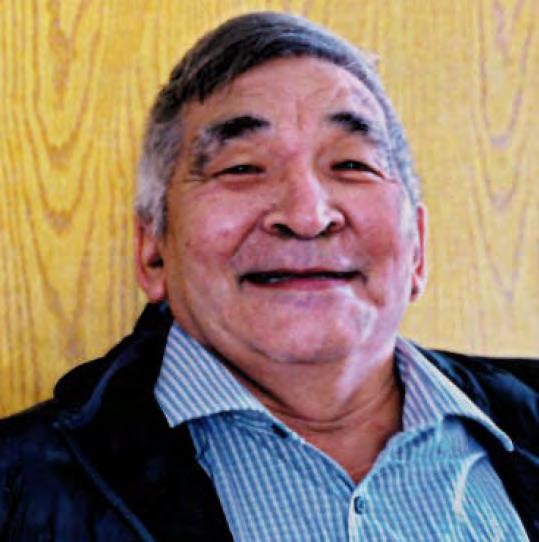
Nunavut News kNKu W?9oxJ5 www.nunavutnews.com A14 Monday, April 3, 2023
ᒪᓕᒐᓕᐅᕐᕕᖕᒥ.
ᑐᒃᓯᕋᐅᒻᒥ ᐊᑦᑕᓇᙱᑦᑐᒥ
ᓄᓇᖃᖅᑎᐅᔪᑦ ᐃᓂᒃᓴᖃᕈᒪᕗᑦ
ᐃᓂᒃᓴᐅᔪᒥ ᐃᒡᓗᓕᒑᕐᔪᖕᒥ
ᐊᕐᕌᒍᓕᒫᒥ
ᐱᓕᕆᓂᐅᔪᒥ
ᐊᖅᑯᒻᒥ ᑲᓱᖃᑎᒌᖕᓂᐅᔪᒥ
ᑲᔪᓯᕗᖅ
ᐊᔪᕐᓇᔾᔮᙱᒃᑲᓗᐊᕐᒪᖔᑦ ᖃᐅᔨᓴᖅᑕᐅᓂᖓᓂ ᐱᔭᕇᖅᑕᐅᓪᓗᖅᐳᖅ ᑕᒪᑐᒪᓂ ᐊᕐᕌᒎᔪᒥ
By Stewart Burnett Northern News Services
Kivalliq
ᖃᐅᔨᓴᖅᑕᐅᓂᐅᔪᒥ ᐊᔪᕐᓇᔾᔮᙱᒃᑲᓗᐊᕐᒪᖔᑦ ᓴᖅᑭᑎᑦᑎᓂᕐᒥ ᓄᓇᓕᖕᓄᑦ−ᑲᑎᑎᕆᓂᐅᔪᒥ ᐊᖅᑯᒻᒥ ᑲᓱᖃᑎᒌᖕᓂᐅᔪᒥ ᑭᕙᓪᓕᕐᒥ ᐱᔭᕇᖅᑕᐅᔪᒃᓴᐅᕗᖅ ᑕᒪᑐᒪᓂ ᐊᕐᕌᒎᔪᒥ ᐊᒻᒪ ᑐᓂᓯᓗᓂ ᑮᓇᐅᔾᔭᒃᓴᓂᕐᒧᑦ ᐊᔪᕐᓇᔾᔮᙱᒃᑲᓗᐊᕐᒪᖔᑦ.
ᑕᐃᕕᑦ ᐊᕿᐊᕈᖅ, ᒥᓂᔅᑕ ᐱᕙᓪᓕᐊᔪᓕᕆᔨᒃᑯᑦ ᐅᓯᑲᑦᑕᕐᓂᕐᒧᓪᓗ, ᐅᖃᓚᐅᖅᐳᖅ ᒪᓕᒐᓕᐅᕐᕕᖕᒥ ᓴᓇᔭᐅᓯᒪᓂᐊᖅᑐᓂᒃ ᐋᖅᑭᒃᓱᐃᔨᐅᓪᓗᑎᒃ ᑎᑎᕋᐅᔭᖅᑎᓂ ᐅᖃᐅᔾᔨᔨᐅᔪᒥ ᐱᓕᕆᓯᒪᕗᖅ ᖃᐅᔨᓴᕐᓂᐅᔪᒥ ᑕᐃᒪᙵᓂ ᐊᐅᕙᐅᓚᐅᖅᑐᒥ. “ᐅᓇ ᐱᓕᕆᓂᖅ ᐃᓚᖃᖅᐳᖅ ᖃᐅᔨᓴᕐᓂᕐᒥ ᐊᕐᕌᒍᓕᒫᒥ ᐊᖅᑯᑎᓄᑦ ᑲᑎᙵᑎᑦᑎᓂᐅᔪᒥ ᓄᓇᓕᐅᔪᓂ ᐊᕐᕕᐊᓂ, ᑎᑭᕋᕐᔪᐊᖅ, ᑲᖏᖅᖠᓂᖅ, ᐃᒡᓗᓕᒑᕐᔪᒃ ᐊᒻᒪ ᖃᒪᓂᑦᑐᐊᕐᒥ,” ᐅᖃᓚᐅᖅᐳᖅ
ᐊᕿᐊᕈᖅ ᑐᓵᔨᑎᒍᑦ ᒪᓕᒐᓕᐅᕐᕕᖕᒥ ᒫᔾᔨ 8−ᒥ.
ᐱᓕᕆᐊᒃᓴᐅᔪᖅ ᑐᓂᓯᓂᐊᖅᐳᖅ ᐊᑭᒃᓴᓂ ᓇᓚᐅᑦᑖᕆᓂᐅᔪᓂ
ᐊᖅᑯᒻᒧᑦ ᓇᑉᐸᖅᑎᕆᓂᐅᔪᒧᑦ, 30-ᐳᓴᓐᑎᖓᓂ ᓴᓇᔭᐅᓂᖓᓂ, ᑮᓇᐅᔾᔭᒃᓴᓂᕐᒧᑦ ᖃᐅᔨᓴᐃᓂᐅᔪᒥ, ᓄᓇᓕᖕᓂ ᐅᖃᖃᑎᖃᕐᓂᐅᔪᓂ
ᐊᒻᒪ ᐱᖁᔭᑎᒍᑦ ᓄᓇᒥ ᐱᓕᕆᓂᐅᔪᒥ ᐸᕐᓇᐃᓂᕐᒧᑦ ᐱᓕᕆᐊᒃᓴᐅᔪᒥ ᑐᓂᔭᐅᓂᖓᓄᑦ ᓄᓇᒥ ᐊᑐᕐᓂᕐᒧᑦ ᐸᕐᓇᐃᓂᕐᒧᑦ ᐊᒻᒪ ᐊᒃᑐᐃᓂᐅᔪᓂ ᕿᒥᕐᕈᔭᐅᓂᖓᓂ ᐱᓕᕆᓂᐅᔪᒧᑦ. “ᓄᓇᖓ, ᐃᓄᒋᐊᖕᓂᐅᔪᑦ ᐊᒻᒪ ᑮᓇᐅᔾᔭᒃᓴᓂᐅᔪᒥ ᑕᒪᑐᒥᖓ ᐃᓚᒋᔭᐅᔪᒥ ᑭᕙᓪᓕᕐᒥ ᐊᕕᒃᑐᖅᑕᐅᓯᒪᔪᒥ ᐱᔪᒥᓇᑦᑎᐊᕋᓗᐊᖅᑎᓪᓗᒍ ᐊᖅᑯᓯ ᓇᑉᐸᖅᑎᕆᓂᐅᔪᒥ, ᓱᓕ ᒫᓐᓇ
ᓈᒻᒪᒃᑐᓂ ᑐᓴᒐᒃᓴᖃᙱᓐᓇᑦᑕ ᐅᖃᕐᓂᕐᒧᑦ ᓴᓇᓂᕐᒥ ᐊᖅᑯᑎᓂ
ᑲᑎᖃᑎᖃᕐᓂᐅᔪᓂ ᐅᑯᓇᓂ ᑕᓪᓕᒪᐅᔪᓂ ᓄᓇᓕᐅᔪᓂ ᐱᐅᓗᓂ
ᐃᑲᔪᕈᓐᓇᖅᐳᖅ ᓴᓇᓂᕐᓂ ᐱᓕᕆᓂᐅᔪᒥ ᐊᖏᔪᓄᑦ ᐊᑭᑐᔫᑎᓄᑦ ᑮᓇᐅᔭᖃᖅᑎᑕᐅᓂᐅᔪᒥ.”
ᒥᓂᔅᑕᐅᑉ ᐅᖃᐅᓯᒃᓴᓕᐊᕆᓚᐅᖅᑕᖓᓂ ᓈᒻᒪᒃᑐᓂ ᑐᓴᒐᒃᓴᖃᙱᓗᐊᕐᓂᖓᓂ ᓱᓕ ᓇᓗᓇᐃᖅᓯᓂᕐᒧᑦ ᐊᖅᑯᑎᓕᐅᕐᓂᕐᒥ ᐅᑯᓇᓂ ᑭᕙᓪᓕᕐᒥ ᓄᓇᓕᐅᔪᓂ ᐱᐅᓗᓂ ᑲᑎᖅᓴᖅᑕᐅᕙᓪᓕᐊᓂᖓᓂ
ᑮᓇᐅᔭᓂ ᑐᖅᑯᖅᑕᐅᓯᒪᓪᓗᑎᒃ
ᓄᓇᕗᒻᒥ
ᑭᓯᐊᓂ
ᐊᕐᕕᐊᑦ ᓂᒋᕐᒥ ᒪᓕᒐᓕᐅᖅᑎ ᔫ ᓴᕕᑲᑖᖅ ᐊᐱᕆᓚᐅᖅᐳᖅ ᒥᓂᔅᑕᒥ ᐱᕙᓪᓕᐊᔪᓕᕆᔨᒃᑯᑦ ᐅᓯᑲᑦᑕᕐᓂᕐᒧᓪᓗ ᑕᐃᕕᑦ ᐊᕿᐊᕈᕐᒥ ᖃᐅᔨᓴᖅᑕᐅᓂᐅᔪᒥ ᑭᕙᓪᓕᕐᒥ ᐊᖅᑯᒻᒥ ᑲᓱᖃᑎᒌᖕᓂᐅᔪᒥ ᐊᔪᕐᓇᔾᔮᙱᒃᑲᓗᐊᕐᒪᖔᑦ ᒪᓕᒐᓕᐅᕐᕕᖕᒥ.
ᐊᒻᒪ ᓄᓇᓕᖕᒥ ᐊᓯᐊᓄᑦ
ᒪᓕᒃᑐᒥ ᑭᒡᓕᐅᔪᒥ ᕿᓂᕐᓂᕐᒧᑦ ᑲᑎᖅᓴᖅᑕᐅᕙᓪᓕᐊᓂᖓᓂ ᑮᓇᐅᔭᓂ ᑐᖅᑯᖅᑕᐅᓯᒪᓪᓗᑎᒃ ᐱᕈᖅᐸᓪᓕᐊᑎᑕᐅᓂᖓᓂ ᑮᓇᐅᔭᓂ ᐆᒧᖓ ᑐᕌᖓᓂᐊᖅᑐᒧᑦ ᐱᒻᒪᕆᕐᔪᐊᖑᔪᒥ ᐱᓕᕆᐊᒃᓴᐅᔪᒧᑦ,” ᐅᖃᓚᐅᖅᐳᖅ ᐊᕿᐊᕈᖅ. ᓴᕕᑲᑖᖅ ᑭᐅᓚᐅᖅᐳᖅ, “ᓂᕆᐅᒃᐳᖓ ᐅᖃᕐᓂᐊᕐᓂᖓᓂ ᐱᐅᓇᔭᕐᓂᖓᓂ ᑲᓱᖃᑎᖃᕐᓂᕐᒥ ᓄᓇᓕᖕᓂ, ᐊᑭᐅᔪᒥ ᐆᒪᓇᓱᐊᕐᓂᕐᒥ ᐊᑦᑎᒃᓯᒋᐊᕐᓂᐊᕐᒪᑦ, ᓅᓐᓂᐅᔪᒥ ᐱᖁᑎᓂ ᐊᒻᒪ ᐃᓚᒌᖑᔪᓄᑦ ᐊᔪᕐᓇᙱᓐᓂᖅᓴᐅᓂᐊᕐᒪᑦ.”
should wrap up this year
By Stewart Burnett Northern News Services
Kivalliq
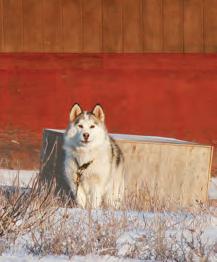
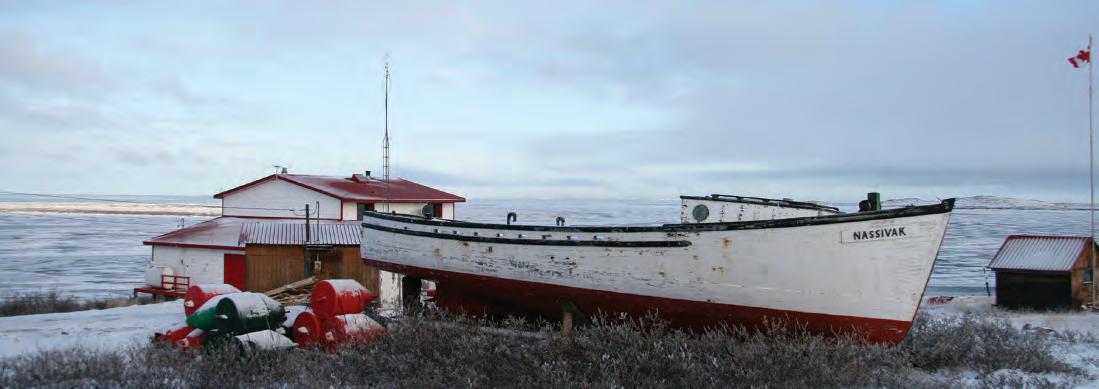
Local Journalism Initiaitive
A study on the feasibility of creating an inter-community road network in the Kivalliq should be finished this year and provide insight on whether the project will be economically feasible. David Akeeagok, minister of economic development and transportation, stated in the legislative assembly that an engineering consultant has been working on this study since last summer.
“This work involves studying all-season road connections between the communities of Arviat, Whale Cove, Rankin Inlet, Chesterfield Inlet and Baker Lake,” said Akeeagok through interpretation in the legislative assembly March 8.
The project will provide cost estimates for the road’s construction, a 30-per-cent design, economic analysis, community consultations and regulatory groundwork to prepare the project for submission to the land use planning and impact review process.
“Although the geography, population and economy of this part of the Kivalliq region are very promising for road construction, we still do not have sufficient information to say whether building road connections between these five communities would be a good investment,” said Akeeagok. “This project will provide the answers we are looking for and could help build the case for major capital funding.”
Arviat South MLA Joe Saviktataaq questioned Akeeagok in the assembly two days later, saying he was surprised about the minister’s statement that there is not yet sufficient information to justify whether building a road between those Kivalliq communities would be a good investment.
“In the Northwest Territories, they’re connecting their communities as quickly as they can to help their communities be not so tied to airlines,” said Savikataaq. “Mr. Speaker, many

of the MLAs here have stated how expensive airline travel is in Nunavut and that’s the only way of getting from one community to another community, unless you go by boat or snowmobile. We want to help Nunavummiut be able to travel freely with the least amount of costs.”
He asked Akeeagok what it would take to determine whether the road network is a good investment or not.
Arviat South MLA Joe Savikataaq asked Minister of Economic Development and Transportation David Akeeagok about the study into whether a Kivalliq road network would be feasible in the legislative assembly. NNSL file photo
“I’m hoping and anticipating that it will (be considered a good investment) and, if it does, we will definitely go into the next level of seeking investment dollars towards this very important project,” said Akeeagok.
Savikataaq replied, “I anticipate that it will say that it is worth connecting the communities, so that the cost of living can go down, so the movement of goods and families will be easier.”
Nunavut News kNKu W?9oxJ5 Monday, April 3, 2023 A15 www.nunavutnews.com
ᑲᑎᖅᓴᖅᑕᐅᕙᓪᓕᐊᓂᖓᓂ ᑮᓇᐅᔭᓂ ᑐᖅᑯᖅᑕᐅᓯᒪᓪᓗᑎᒃ ᐱᕈᖅᐸᓪᓕᐊᑎᑕᐅᓂᖓᓂ,” ᐅᖃᓚᐅᖅᐳᖅ ᐊᕿᐊᕈᖅ. “ᐅᓇ ᐱᓕᕆᐊᒃᓴᐅᔪᖅ ᑐᓂᓯᓂᐊᖅᐳᖅ ᑭᐅᔾᔪᑎᒃᓴᓂ ᕿᓂᖅᑕᑦᑎᓐᓂ ᐊᒻᒪ ᐊᕐᕕᐊᑦ ᓂᒋᕐᒥ ᒪᓕᒐᓕᐅᖅᑎ ᔫ ᓴᕕᑲᑖᖅ ᐊᐱᖅᓱᓚᐅᖅᐳᖅ ᐊᕿᐊᕈᕐᒥ ᒪᓕᒐᓕᐅᕐᕕᖕᒥ ᒪᕐᕉᑦ ᐅᓪᓗᑦ ᐊᓂᒍᖅᑎᓪᓗᒍ, ᐅᖃᖅᖢᓂ ᑲᒪᓚᐅᕐᓂᖓᓂ
ᐱᕈᖅᐸᓪᓕᐊᑎᑕᐅᓂᖓᓂ. “ᓄᓇᑦᓯᐊᕐᒥ, ᑲᑎᖃᑎᖃᖅᐸᓪᓕᐊᕗᑦ ᓄᓇᓕᖏᓐᓂ ᓱᒃᑲᔪᒥ ᐃᑲᔪᕈᓐᓇᕐᒪᑕ ᓄᓇᓕᖏᓐᓂ ᑲᑎᙵᓂᖃᓗᐊᕌᓗᒋᐊᖃᙱᓐᓂᖏᓐᓂ ᖃᖓᑕᓲᓄᑦ,” ᐅᖃᓚᐅᖅᐳᖅ ᓴᕕᑲᑖᖅ. “ᐅᖃᖅᑏ, ᐊᒥᓱᑦ
ᑖᓐᓇᑐᐊᖑᕗᖅ,
ᐅᒥᐊᒃᑰᕈᕕᑦ ᓯᑭᑑᒃᑯᓪᓘᓐᓃᑦ. ᐃᑲᔪᕈᒪᕗᒍᑦ ᓄᓇᕗᒻᒥᐅᓂ ᐃᓱᒪᖅᓱᕐᓗᑎᒃ ᐊᐅᓪᓛᕈᓐᓇᕐᓂᕐᒧᑦ ᒥᑭᓛᖑᔪᒥ ᐊᑭᐅᔪᓄᑦ.” ᐊᐱᕆᓚᐅᖅᐳᖅ ᐊᕿᐊᕈᕐᒥ ᖃᓄᐃᑦᑕᕆᐊᖃᕋᔭᖅᐸᑦ ᐃᓱᒪᓕᐅᕆᓂᕐᒥ ᐊᖅᑯᑎᒧᑦ ᑲᓱᖃᑎᒌᖕᓂᐅᔪᒥ ᐱᐅᓗᓂ ᑲᑎᖅᓴᖅᑕᐅᕙᓪᓕᐊᓂᖓᓂ
ᒪᓕᒐᓕᐅᖅᑎᐅᔪᓂ ᐅᕙᓂ ᐅᖃᖅᓯᒪᕗᑦ ᐊᑭᑐᓗᐊᕐᓂᖓᓂ ᖃᖓᑦᑕᐅᑎᓂ
ᓄᓇᓕᖕᒧᐊᕐᓂᕐᒧᑦ
ᑮᓇᐅᔭᓂ ᑐᖅᑯᖅᑕᐅᓯᒪᓪᓗᑎᒃ ᐱᕈᖅᐸᓪᓕᐊᑎᑕᐅᓂᖓᓂ ᐋᒃᑲᓘᓐᓃᑦ. “ᓂᕆᐅᖕᓂᖃᖅᐳᖓ ᐊᒻᒪ ᓂᕆᐅᒃᐳᖓ (ᐃᓱᒪᒋᔭᐅᓂᐊᕐᓂᖓᓂ ᐱᐅᓗᓂ ᑲᑎᖅᓴᖅᑕᐅᕙᓪᓕᐊᓂᖓᓂ ᑮᓇᐅᔭᓂ ᑐᖅᑯᖅᑕᐅᓯᒪᓪᓗᑎᒃ ᐱᕈᖅᐸᓪᓕᐊᑎᑕᐅᓂᖓᓂ) ᐊᒻᒪᓗ, ᑕᐃᒪᐃᒃᑯᓂ, ᑐᕌᓪᓚᕆᖕᓂᐊᖅᐳᒍᑦ
All-season road network work continues Feasibility study
QIA continues to grow as an organization, president says
Important to have representation in wildlife dicussions, says Olayuk Akesuk
By Trevor Wright Northern News Services Iqaluit
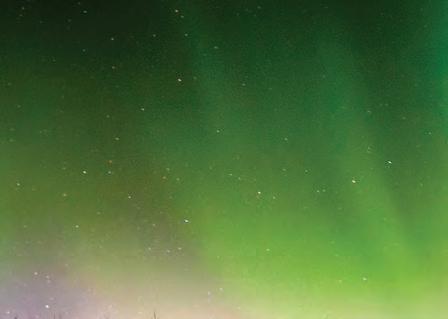
The Qikiqtani Inuit Association (QIA) continues to expand, it was noted during the organization’s board of directors meeting.

The meeting took place at Iqaluit’s Aqsarniit Hotel and Conference Centre from March 29 to 30.




“Over the past few years our organization has grown a lot, including the marine and wildlife department. We have an Inuit knowledge (Inuit Qaujimajatuqangit) department and we have other departments that are there in which they’re continuing to grow,” said QIA President Olayuk Akesuk, on a break during QIA’s 2023-24 budget discussion, adding this is a trend the organization wants to continue.
“That’s what we want to do, to make sure we represent our people in a political area where we want to be heard.”
The growing role of QIA’s Marine and Wildlife Department is an example of this, with a growing list of Nauttiqsuqtiit Land Guardians being employed and sought by QIA in Grise Fiord, Clyde River, Resolute Bay, Pond Inlet and Arctic Bay.
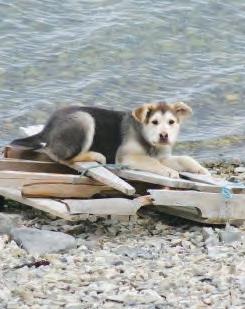
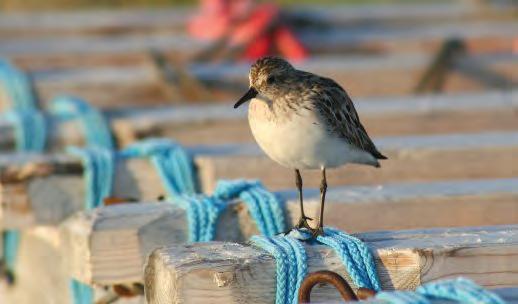
Last June, QIA purchased the old Co-Op Hotel in Resolute Bay to convert it into a multi-use facility for Nauttiqsuqtiit Land Guardians with similar initiatives underway in other communities.
The Nauttiqsuqtiit stewards are the caretakers of the Tallurutiup Imanga Inuit Impact and Benefit Agreement of the Tallurutiup Imanga national marine conservation area from Resolute to east of Bylot and Devon Island. They monitor sea ice conditions and keep an eye on the environment in their region.
The Nunavut Wildlife Board and Qikiqtani Wildlife Board are the main instruments of wildlife management in the Qikiqtani region, with the decisions of those two organiza-
tions having the potential to impact the lives of Qikiqtani Inuit.

“It’s important to have a wildlife department to ensure that we represent our people in that field,” Akesuk said, whether it’s input on caribou herds, narwhal populations and other animals. “We want to be a part of the decisions or discussions in the future which might impact our people in our region on a living day-to-day basis.”
Collecting traditional knowledge also has a role to play when it comes to presenting information and talking about wildlife management in Qikiqtani.
“The Inuit Qaujimajatuqangit Department, we also collect (knowledge) from our people, we take that so we can use it during discussions on wildlife. This is the information that we got, now we have (the details) written and recorded to make sure these are the accurate answers, or what our people have seen over the last 5,000 years of living in our territory.”
Nunavut News kNKu W?9oxJ5 www.nunavutnews.com A16 Monday, April 3, 2023 x0p31Axy N4ystdJxl4
ᕿᑭᖅᑕᓂ ᐃᓄᐃᑦ ᑲᑐᔾᔨᖃᑎᒌᑦ ᐊᖓᔪᖅᑳᖓ ᐅᓛᔪᒃ ᐊᑭᓱᒃ ᐊᒻᒪ ᕿᑭᖅᑕᓂ ᐃᓄᐃᑦ ᑲᑐᔾᔨᖃᑎᒌᑦ ᐊᖓᔪᖅᑳᑉ ᑐᒡᓕᐊ ᓕᕙᐃ ᐹᓇᐸᔅ ᓈᓚᓲᖑᕗᑦ ᑮᓇᐅᔭᑦ ᐊᑐᖅᑐᒃᓴᑦ ᓇᓗᓇᐃᖅᓯᒪᔪᓂᒃ ᐱᒋᐊᓵᖅᑎᓪᓗᒋᑦ ᕿᑭᖅᑕᓂ ᐃᓄᐃᑦ ᑲᑐᔾᔨᖃᑎᒌᑦ ᑲᑎᒪᔨᖏᑦ ᑲᑎᒪᑎᓪᓗᒋᑦ ᒫᔾᔨ 29−ᒥ.
Qikiqtani Inuit Association President Olayuk Akesuk, left, and QIA VicePresident Levi Barnabas listen to budget details at the outset of QIA’s board of directors meeting on March 29. Trevor Wright/NNSL photo

Nunavut News kNKu W?9oxJ5 Monday, April 3, 2023 A17 www.nunavutnews.com www.nunavutnews.com Stay healthy by staying active! EMPLOYMENT, LEGAL NOTICES & TENDERS NUNAVUT ADVERTISING HOTLINE • Email: classifieds@nnsl.com Fax: 867-873-8507 or Email: advertising@nunavutnews.com NUNAVUT TRADING POST FREE BUY & SELL ADS jobs.nnsl.com! 10 áœÀéúΩÄî ΩÒïŒÒéîé≤Í≠î êΩËîΩ≤ 10 Reasons to Advertise in the Classifieds •Announcements •Misc. For Sale •Vehicles •Real Estate •Childcare •Garage Sales •Misc. Wanted •Pets •Business Opportunities •Lost & Found Call Classifieds Ph. 867-873-9673 • Fax 867-873-8507 classifieds@nnsl.com www.nnsl.com •êΩÒíÇÌÕÇÀî •ª∂êÄ∏∂Äî ≤Ç›îΩÄî •¥∂πÇéî •Ä∆¬Äî •ãĉ≤Ò •ÖÚÍË´ ≤Ç›ËÒéîé≤Ò •ª∂êÄ∏∂Äî áÀØÕÇÀî •ÉØÀÌéî •á∂ªÖÍ›úΩÄî •ÖπÇ«ÕÇπØÀî & ∂≤ÕÇπØÀî ǃ›ù¬ùî êΩËîΩ¿‰«î ǃÇî 867-873-9673 ªúöÀÒ 867-873-8507 classifieds@nnsl.com www.nnsl.com 867-873-4031 Your message travels farther with us. TO ADVERTISE CONTACT Our website gets over 276,000 views per month ADVERTISING@NUNAVUTNEWS.COM
Nunavut News kNKu W?9oxJ5 www.nunavutnews.com A18 Monday, April 3, 2023 EMPLOYMENT, LEGAL NOTICES & TENDERS
on the Web All tenders advertised in the current editions of Inuvik Drum, NWT News/North, Nunavut News/North, Kivalliq News and Yellowknifer are also available on the NNSL website. For more information on how to access them, contact circulation@nnsl.com Nourishing our children's future! Give children the best start with healthy eating every day.
Tenders
wake up to a world of new career opportunities with the “Northern Jobs” section of the classifieds.
Check out new listings every week.



Find jobs in your own area of expertise or set out on a new career path. You’ll also find information about area employment agencies and career management centers, whose services can simplify your job search. So, don’t delay; turn to the classifieds and get started today!
www.nunavutnews.com
Nunavut News kNKu W?9oxJ5 Monday, April 3, 2023 A19 www.nunavutnews.com EMPLOYMENT, LEGAL NOTICES & TENDERS
WHEN IT’S TIME FOR A CHANGE...
RECYCLE THIS NEWSPAPER!















Nunavut News kNKu W?9oxJ5 www.nunavutnews.com A20 Monday, April 3, 2023




































































